Xanthi, the lady and lord of Thrace
General history of Xanthi
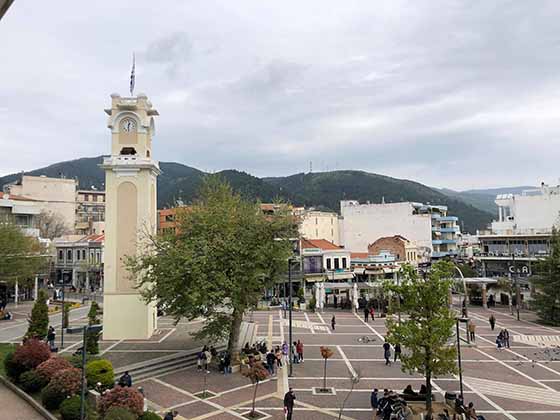
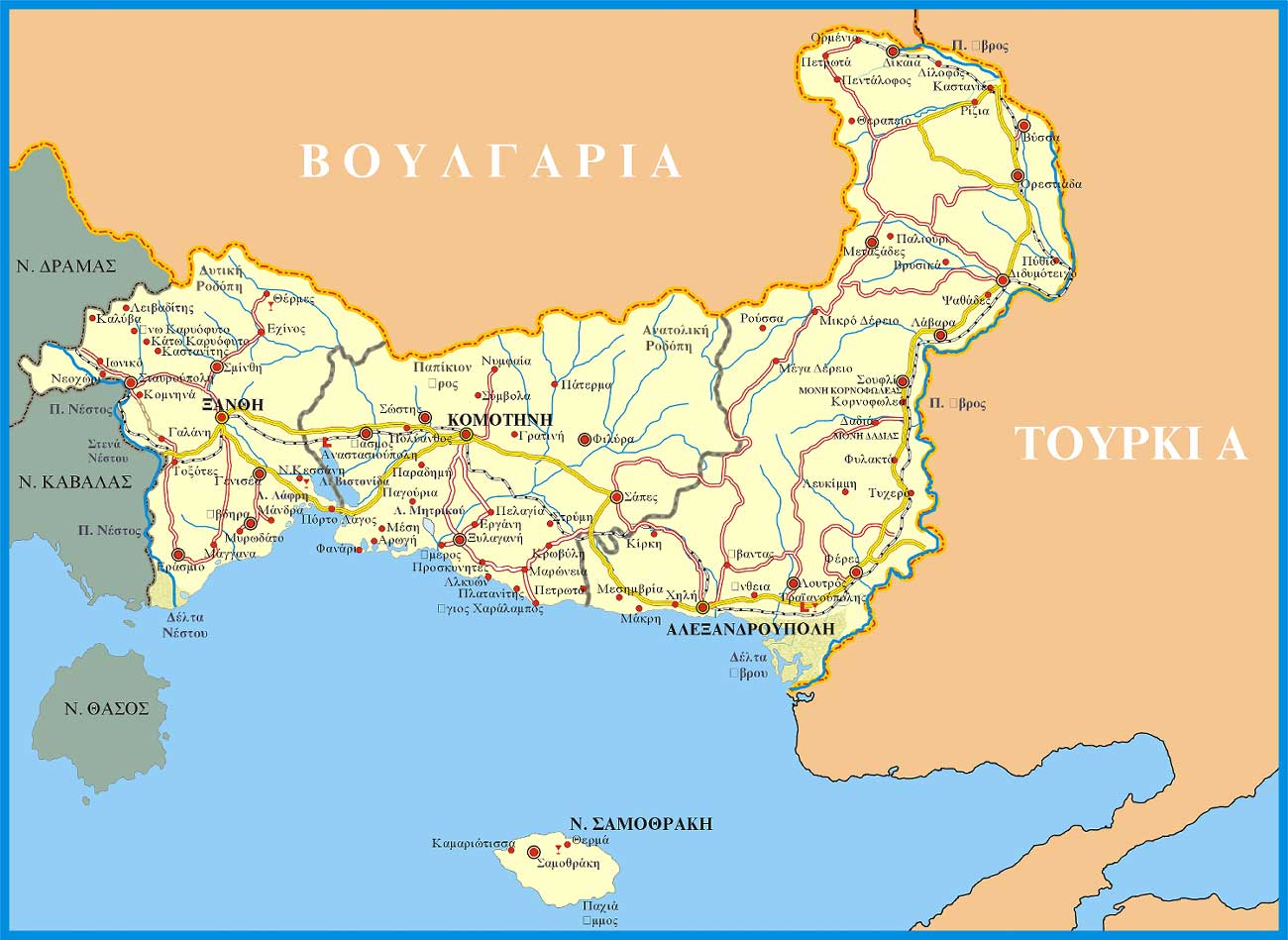
In the area between Lake Vistonis (east) and the Nestos River (west), in ancient times, lived the Thracian tribes of the Vistoni (near Lake Vistonis) and the Sappaei (west of the Vistoni and up to the Nestos River). In the mountainous parts of the same area lived the Thracian tribes of the Trausi (northeast, in the valley of the Travos River, which flows through the Echinos Valley and empties into Lake Vistonis), the Satri to the north, and the Dioni in the Nestos Valley.
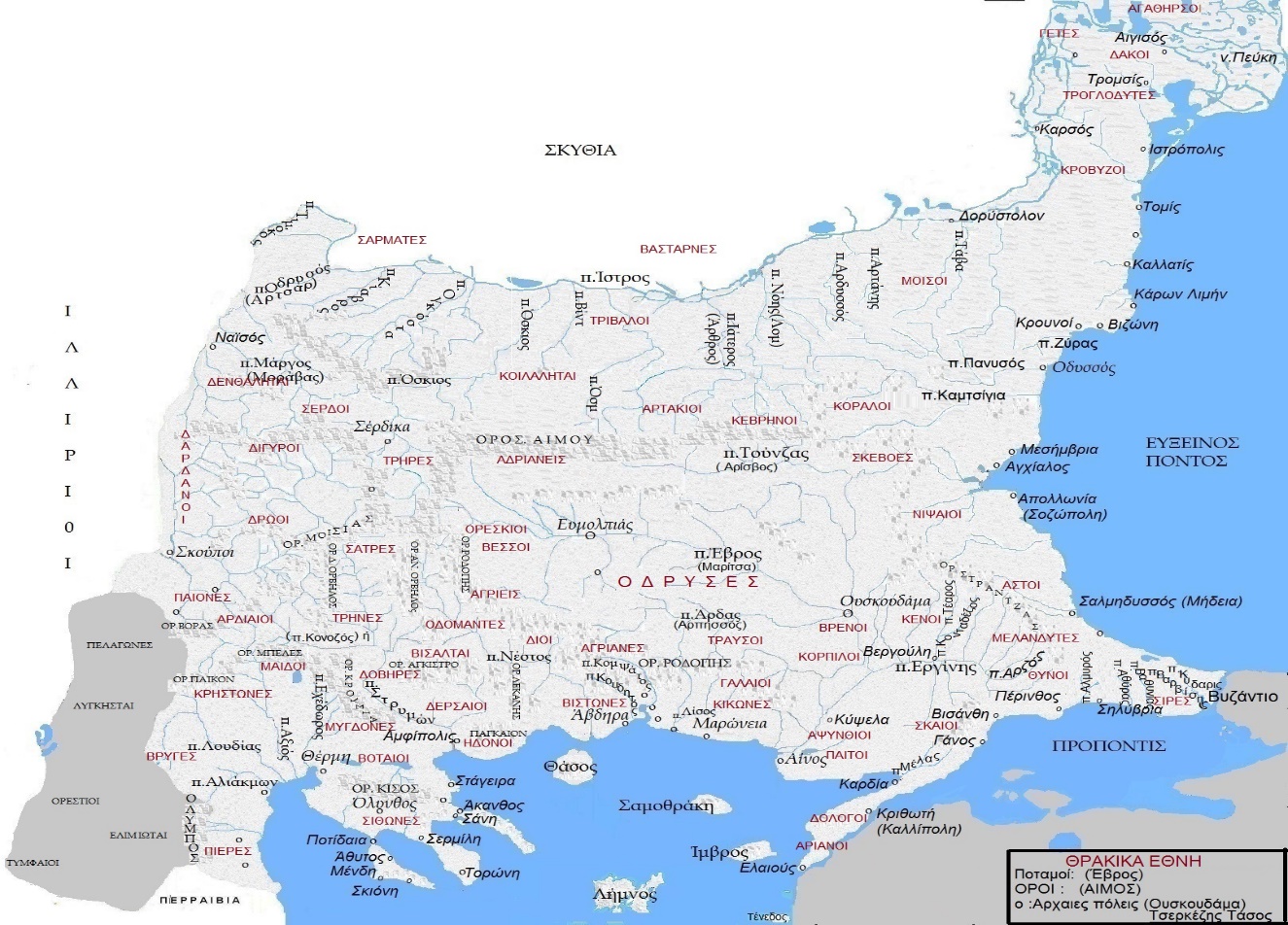
In ancient times, the village located at the crossing of the Kossinitis – Kosynthos river was called Para (to) and meant the passage, crossing, that is, the same meaning as the southern Greek poros: crossing. Over time, the name of the village was joined with the article “to” and thus it was renamed Topara or Topeiros with the same meaning. In the 6th century BC, Avdera was founded, the most important city of antiquity for our region, homeland of the philosopher Democritus and the sophist Protagoras.
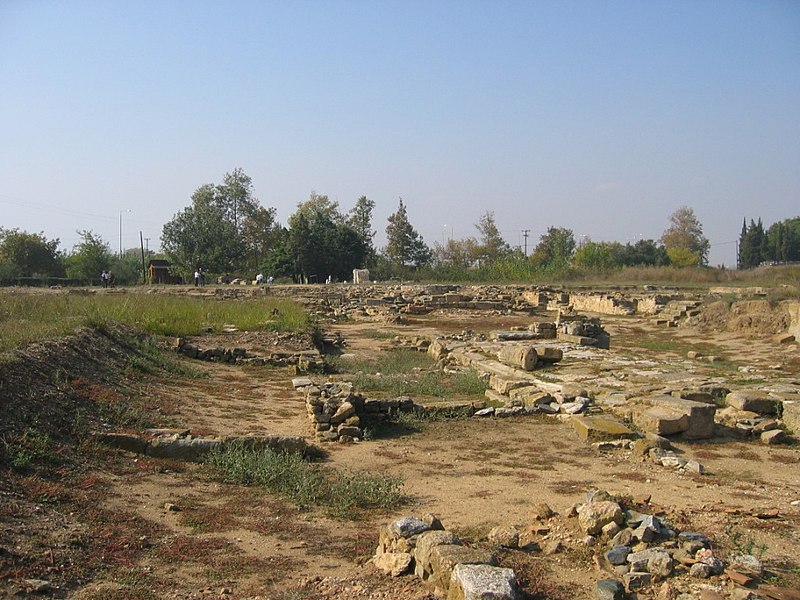
Archaeological site of Avdera (source: Wikipedia)
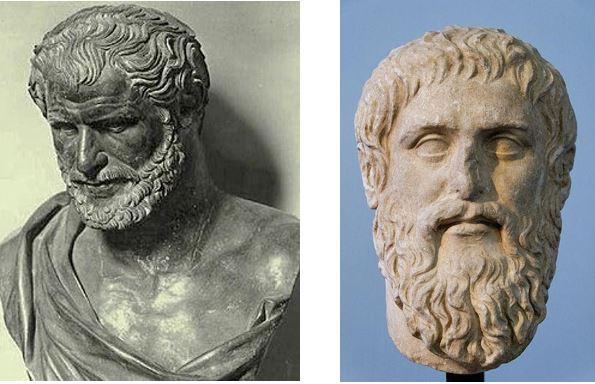
The philosopher Democritus and the sophist Protagoras
In the 5th century BC, the Persians passed through Thrace and briefly occupied it in their unsuccessful campaign against the Greeks. In the 4th century BC, Philip II built a powerful fortress in the mountains of our region, on the Kales hill, called “Kastro Kalyva”, which operated until the time of Justinian.
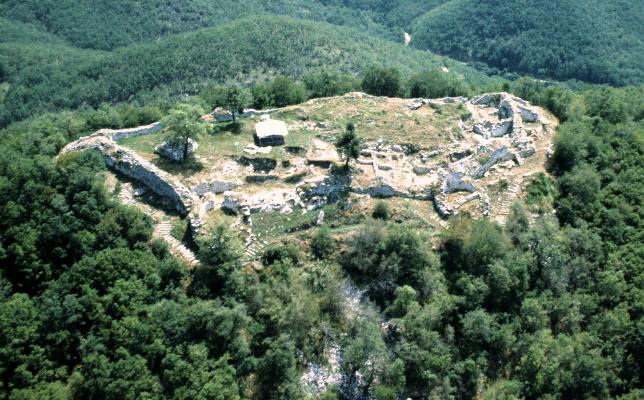
Kalyva Castle from above
Later, the Thracian tribe of Rhodope Agrianes (who are in one view the ancestors of the modern Pomaks) followed Alexander the Great in his own successful campaign against the Persians.
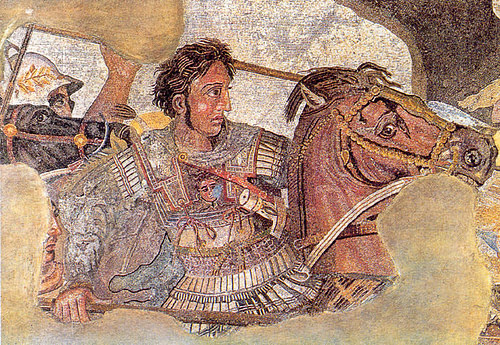
Alexander The Great
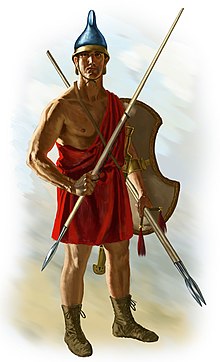
Agrian peltast
Then Thrace passed into the Roman Empire. The great geostrategic importance of the place is shown by the creation by the Romans of the Via Egnatia, which passed through Topeiros, the name of our region at that time. With the passage of the Via Egnatia (100 BC) the village developed into a rich and prosperous “free” city with its own coins.
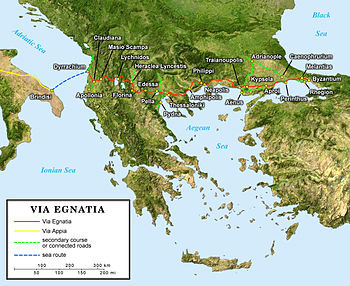
The Via Egnatia during the Roman era (source: Wikipedia)
From the 8th century AD the name of the area became Rousio and later Xantheia. From the Byzantine era we only have some references to Xantheia as a metropolis in ecclesiastical texts, but also in historical ones as a station of Byzantine generals and emperors. To the north of our city there is part of its walls from that time.
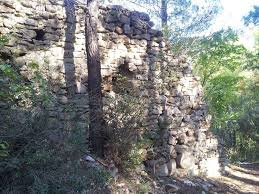
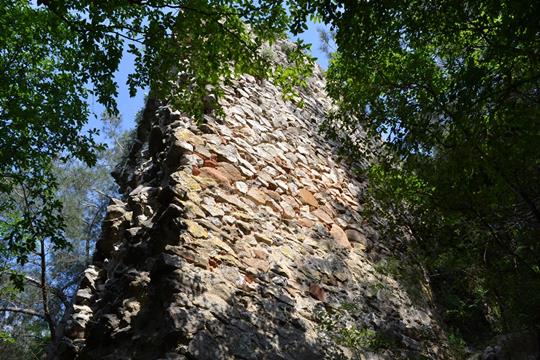
(source: Municipality of Xanthi)
In 1385 AD, Xanthia was conquered by the Ottomans. From then on, a very difficult period began, full of confiscations, oppression, torture and taxes against the Christian inhabitants of the city, which despite many trials did not lose its Greekness. On the contrary, it was an important Greek-Christian center between Adrianople and Thessaloniki and many persecuted Greeks from the wider Thracian and Macedonian lands took refuge here. Thus, the Greek element always overwhelmingly prevailed in the city even after the outbreak of the revolution of 1821 and the terrible reprisals suffered by the Greeks. Another great disaster occurred in 1829, when two major earthquakes leveled the city, which had to be built from scratch.
Meanwhile, the spread of tobacco cultivation in the region since the 18th century had highlighted its type of tobacco, basma, as unique and sought-after in the sultan’s palace. In 1860, a fire burned down Yenisea, the seat of the region’s governor and a center for tobacco processing and trading. The seat of the governor was moved to Xanthi, as were the activities of the tobacco merchants. Then began a period of economic prosperity for the city, as tobacco warehouses were erected and tobacco workers flocked to process and trade its tobacco, whose fame exceeded the borders of the Ottoman Empire and became sought-after from Russia to Egypt and Austria.
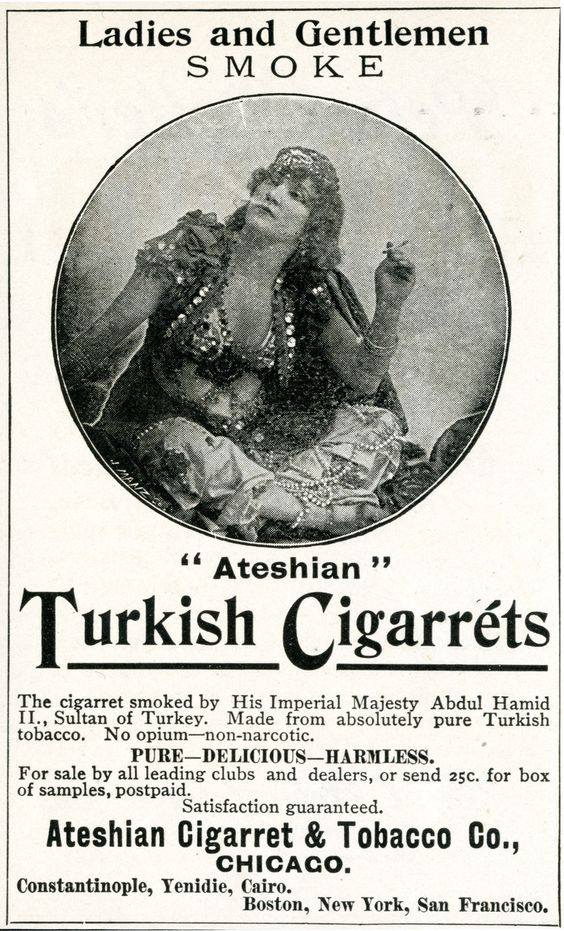
American advertisement for the Armenian tobacco manufacturer Atesian, 1894. At the bottom we see Yenidie (turkish name of Xanthi) looming among the megacities. (source: Old Photos of Xanthi, archive: Manolis Houmas)
At that time, the famous Xanthi Clock was built by the aristocrat Hadji Emin Aga as part of a dedication to the city’s central mosque. The Tower was part of the “Agora Mosque”, which was destroyed in 1941 by the Bulgarian invaders, while the Clock had been renovated in 1938 in its current form.
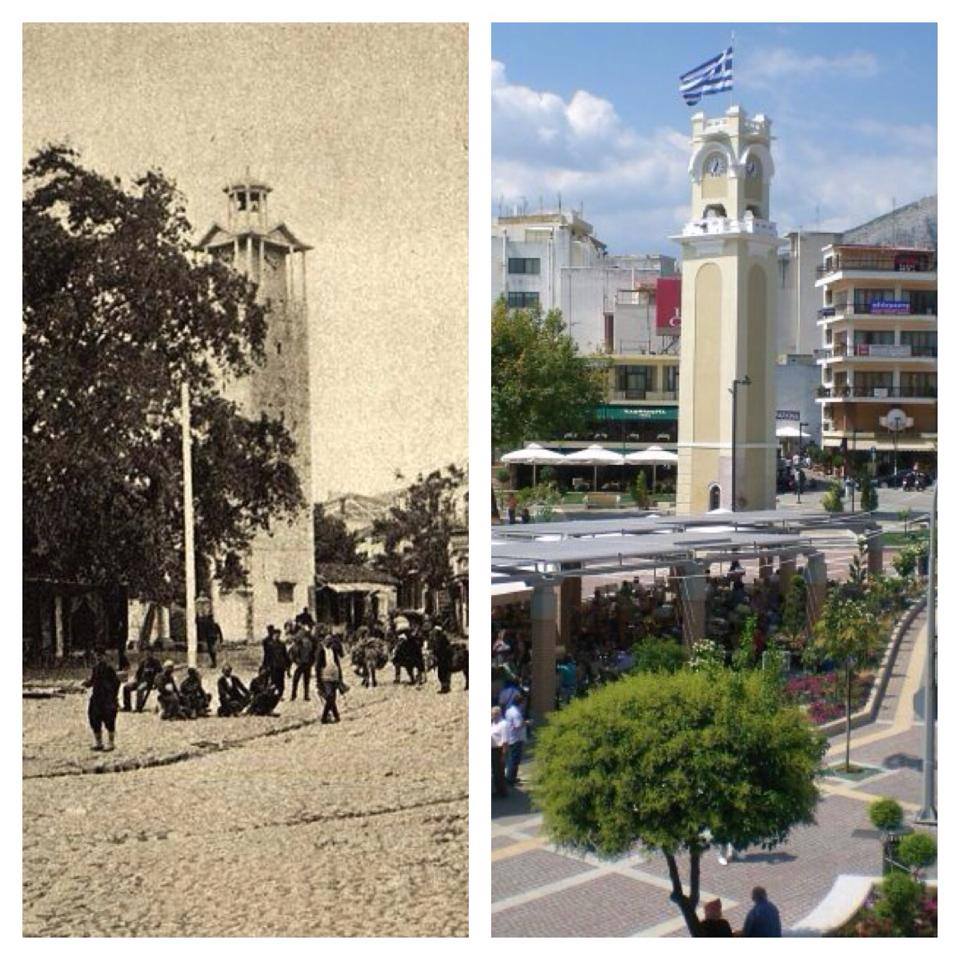 The clock in 1916 and 2013 (source: Old Photos of Xanthi)
The clock in 1916 and 2013 (source: Old Photos of Xanthi)
The Xanthi tobacco merchants, mainly Greeks, formed a strong bourgeoisie and Xanthi developed into a large urban and industrial center. At that time, the mansions of the old city were built with eclectic architectural elements by Epirus and Macedonian craftsmen.The traditional settlement was composed of impressive neoclassical mansions, folk-style Balkan houses, inns, shops, beautiful churches and among them labyrinthine cobblestone alleys. The settlement that was formed during that prosperous era, the Old Town of Xanthi, as it is known today, is a valuable cultural asset for all of Thrace. In 1976, it was declared a protected settlement with 1,200 designated listed buildings. (information from the Xanthi Municipality website).
In addition to the beautiful houses, many educational and charitable institutions were also built, since the wealthy Greek tobacco merchants, such as Michael Matsinis, Panagiotis Stalios, Pantelis Kougioumtzoglou, were interested in the education of young people and the contribution to the community. A typical example is the impressive boys’ and girls’ school of Michalis Matsinis, which many years later evolved into the 1st Primary School of Xanthi
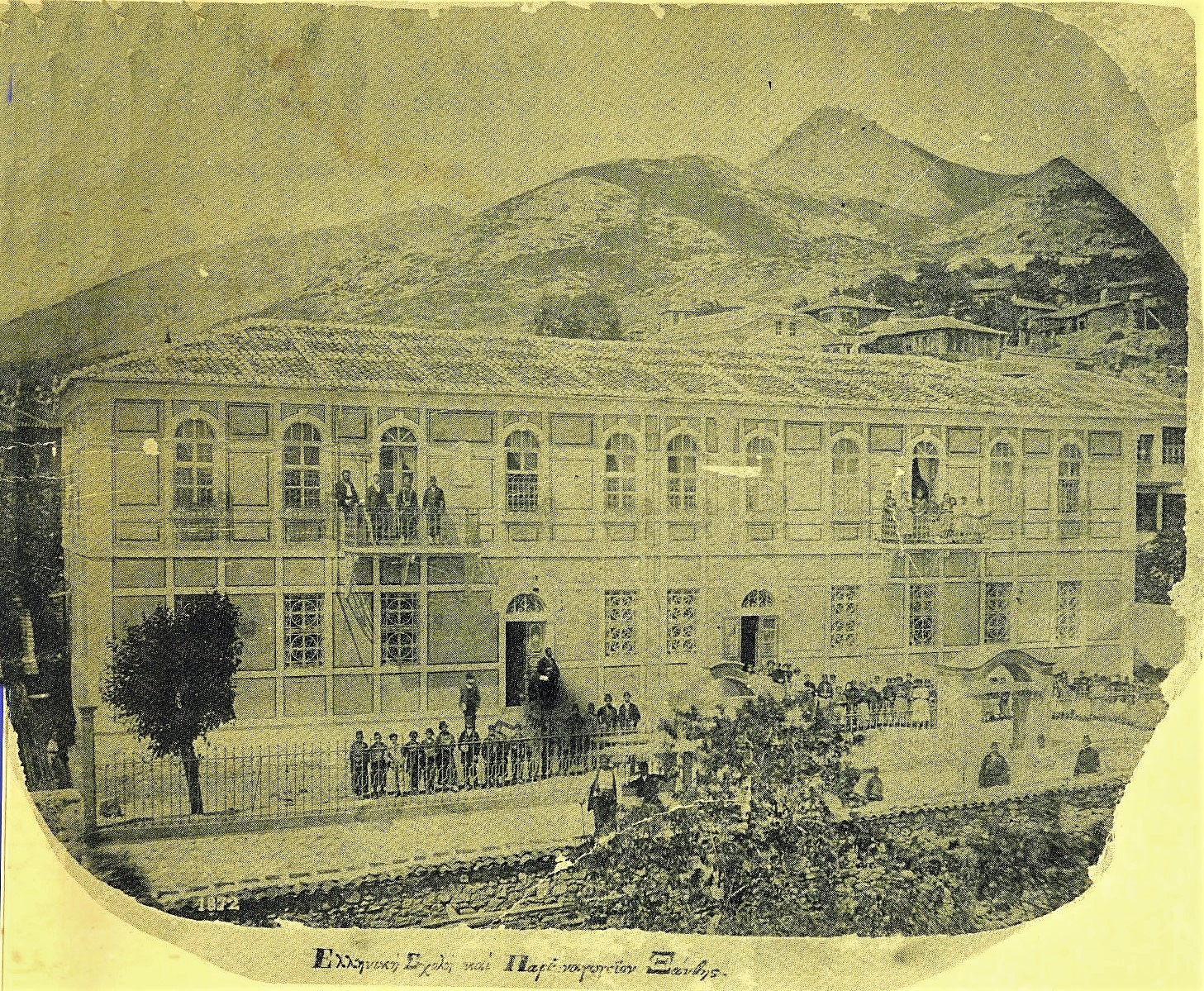
From the cover of the Album XANTHI 1870-1940 by the late Stefanos Ioannidis
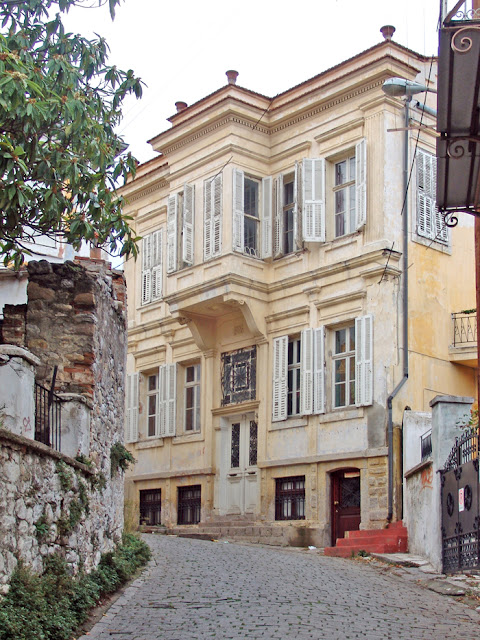
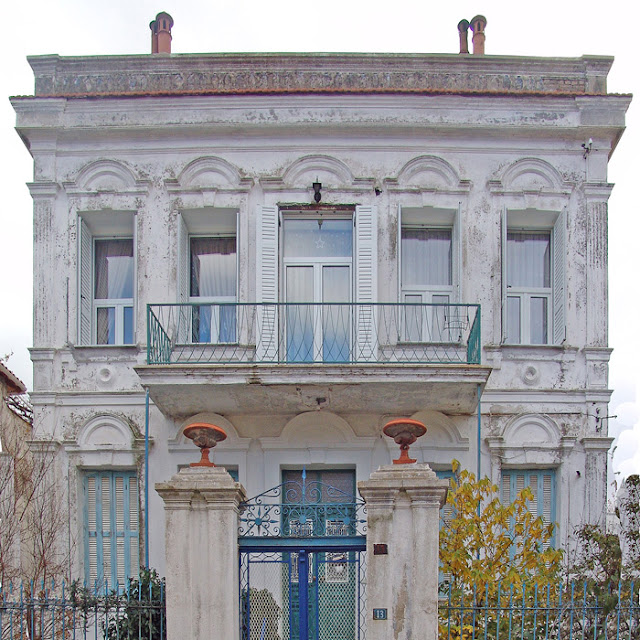
Manors in the old town (photo source: Old Xanthi blog)
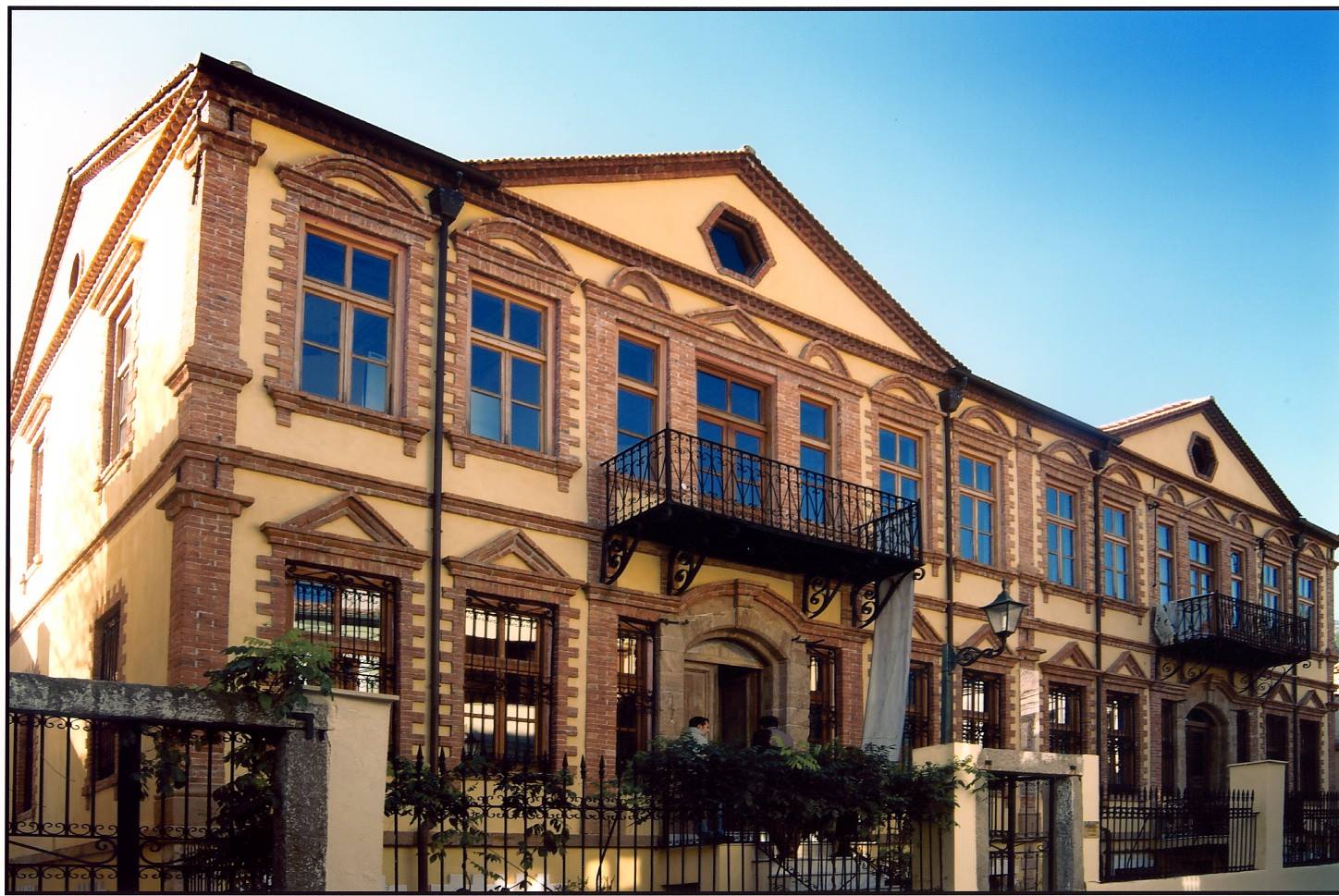
The Kougioumtzoglou mansion and now the folklore museum of Xanthi (source: Municipality of Xanthi)
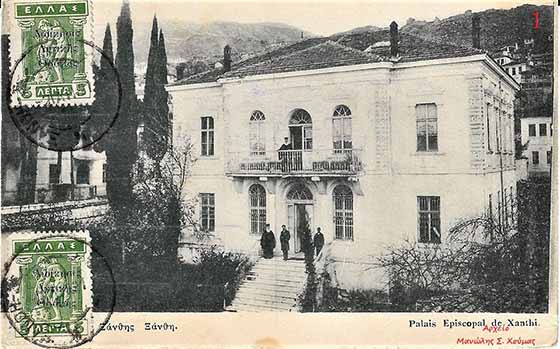
The metropolitan palace at the beginning of the 20th century (archive Manolis Choumas)
Around 1900, in Xanthi there were four consulates, three banks, dozens of insurance offices, hotels, dozens of inns, cultural associations, professional and charitable associations, the famous “Apollon” theater, a cinema, numerous shops, schools and institutions, churches, monasteries and an imposing metropolitan palace. Xanthi was then called “little Paris”.
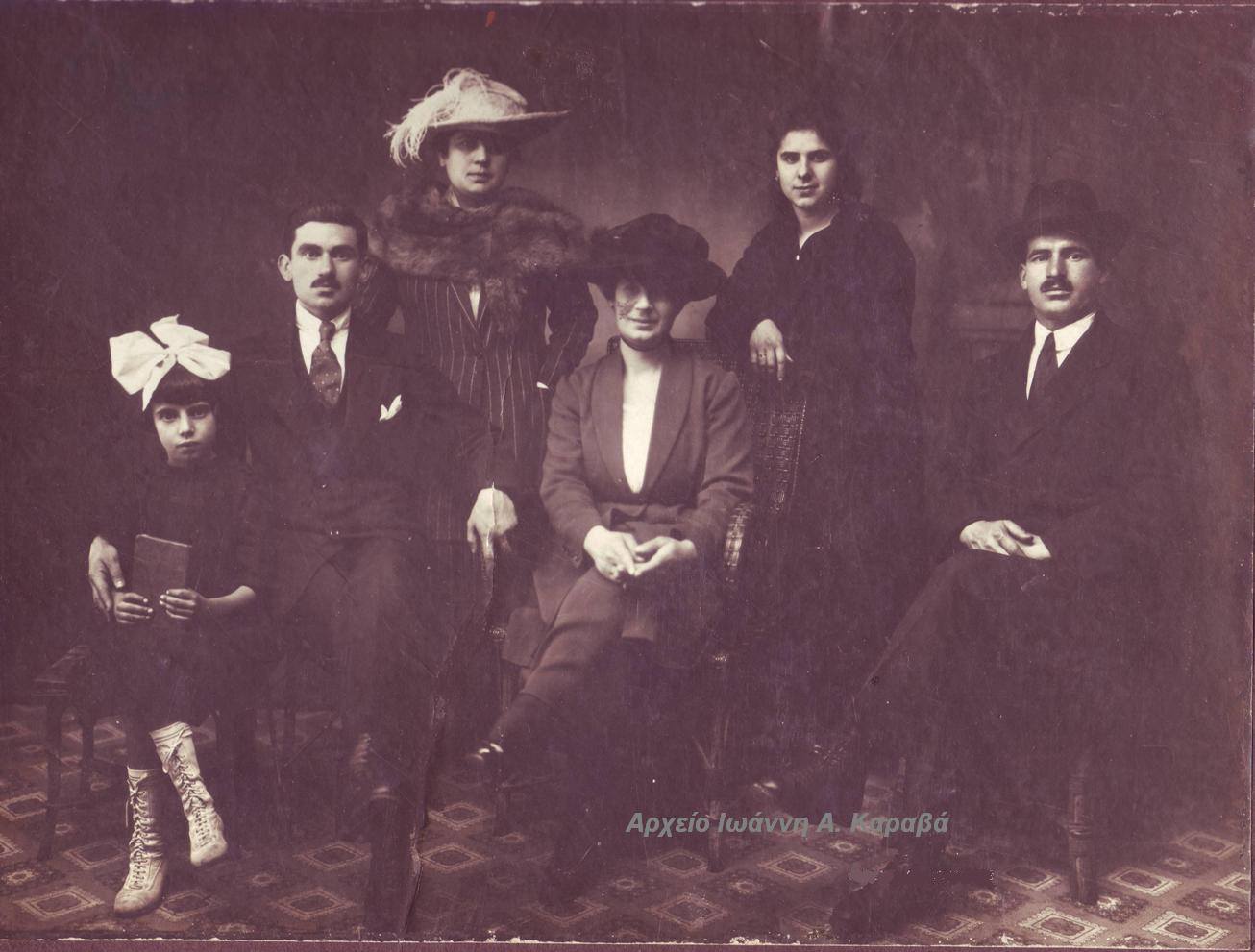 Members of the family of the tobacco merchant P. Zouliami
Members of the family of the tobacco merchant P. Zouliami
However, at the beginning of the 20th century, the peoples of the Balkans had begun to seek their liberation from the Turkish yoke and the creation of independent national states. Thus, in October 1912, the First Balkan War broke out with the coalition of Greece, Bulgaria, Serbia and Montenegro against the Ottoman Empire.
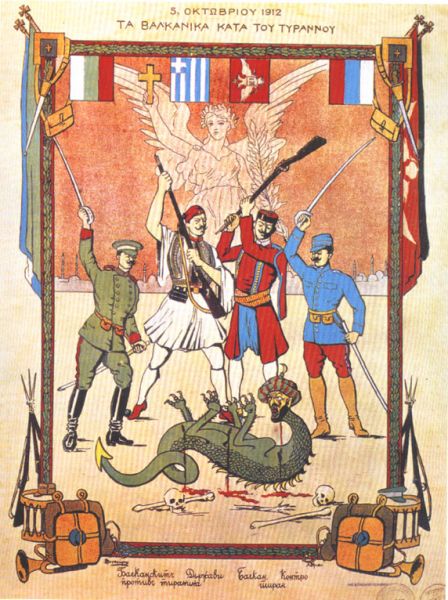
(source of picture, Wikipedia)
The Greeks managed to liberate western Macedonia and Thessaloniki. The Bulgarians, eastern Macedonia and Thrace. On November 8, 1912, the Bulgarians entered Xanthi as liberators. The people of Xanthi welcomed them with great enthusiasm, but the 8-month occupation that followed revealed their plans for the violent bulgarization of the region. The differences that emerged between the victors of the First Balkan War quickly led to a second war from June 29 to August 10, 1913, very short, but also very bloody, with Greece, Serbia and Montenegro this time allied against Bulgaria, which was defeated.
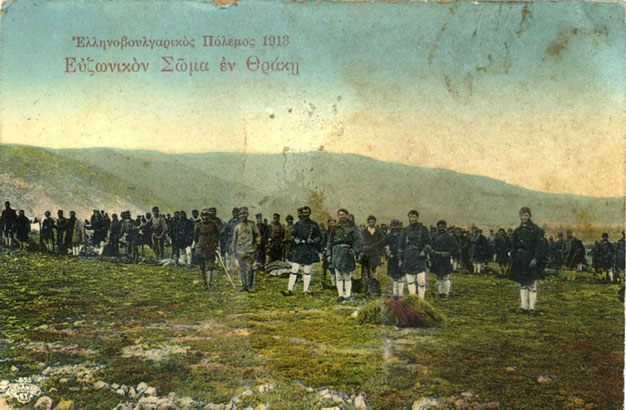
July 1913. Units of the 8th Infantry Division of General Dimitrios Matthaiopoulos, who were camped on the heights of old Morsini before advancing and liberating Xanthi. (source of picture, f/b Old Photographs of Xanthi)
On July 13, 1913, the Greek army triumphantly entered the city from its northern side, while the previous day the defeated Bulgarians had left in a hurry and disorderly manner.
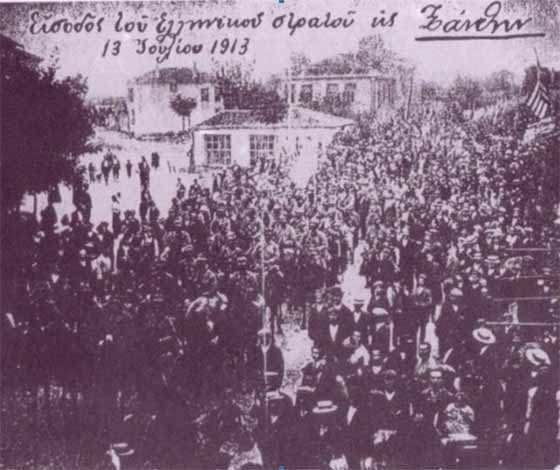
The army was received with enthusiasm by the people of Xanthi. Unfortunately, the joy of this first liberation lasted only a short time, only 2 weeks, because with the Treaty of Bucharest on July 28, Western Thrace was completely arbitrarily ceded to the defeated Bulgaria. The Greek army withdrew and very soon a large part of the Greek population of Xanthi also fled as refugees to eastern Macedonia.
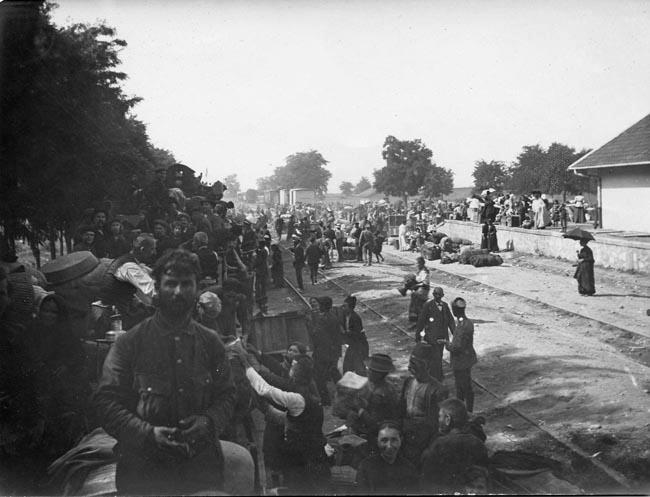
The escape of the Xanthiites from the Toxotes railway station (source of pictures, f/b Old Photographs of Xanthi)
This happened because from the very beginning of the Bulgarian occupation, measures were implemented to exterminate the Greek element, such as persecutions, closing schools, destruction of books and records related to Hellenism, confiscation of property and looting, conscription of Xanthi residents into labor battalions, prohibition of the Greek language and much more.
The situation changed radically with World War I, which lasted from July 1914 to November 11, 1918. Greece sided with the Entente powers, that is, with England, France, Russia and the USA, while Bulgaria sided with the Central Powers, Germany, Austria-Hungary and the Ottoman Empire. At the end of the war, Greece found itself on the side of the victors, while Bulgaria was on the side of the losers. The terms of the peace treaty were negotiated at the so-called “Paris Peace Conference” in 1919. The long-suffering Western Thrace was claimed by: the Greeks of course, the Turks, the Bulgarians who had been disarmed but remained in the area, and even the French, behind the scenes of course. Greece’s position was difficult and a tough diplomatic struggle was needed to convince it of its demands.
In September 1919, the Peace Council decided that Bulgaria had to evacuate Western Thrace and that General-in-Chief Françet d’Esperais should take care of the occupation of the region by Allied troops. The Greek divisions would advance to occupy the area of Xanthi and part of Komotini, to annex them to Greece, while the remaining allied forces would advance in the remaining area from Iasmos to Evros. However, all of Thrace would temporarily constitute a single state entity under the name “Inter-Allied Thrace”.
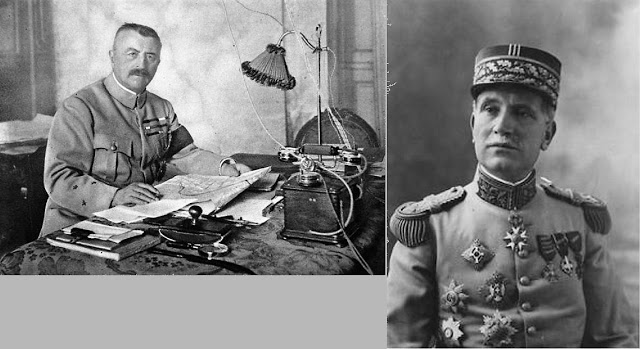
On the left is the French General-in-Chief – Commander of the Allied Army of the East, François d’Espères. On the right is the French General Charles Antoine Charpy, D’Espères’ plenipotentiary and Commissioner of the liberated Western Thrace.
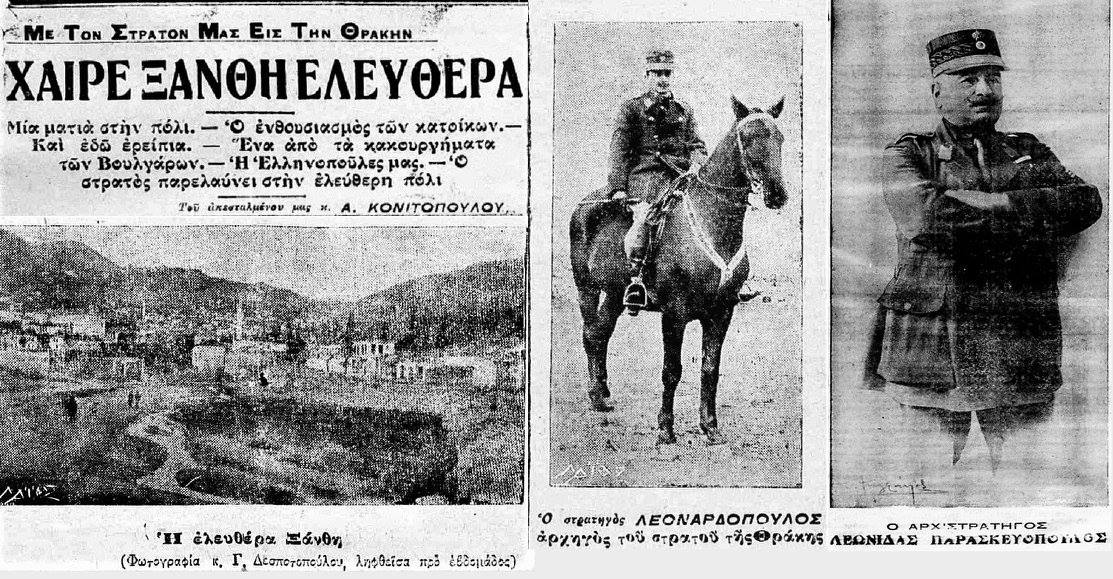
On horseback is the Eleftherotis general Georgios Leonardopoulos (1867-1936), commander of the 9th Division. PATRIS newspaper Sunday 6 Oct 1919. On the right is the commander-in-chief Leonidas Paraskevopoulos (1860-1936). FOS newspaper, Thessaloniki, Tuesday 1 Oct 1919. Archive: Manolis Choumas.
On 2nd October 1919, the 9th Greek Division, stationed in Paranesti, was ordered to proceed to occupy the Xanthi triangle. The next day, they advanced through Stavroupoli and Lykodromi, where they spent the night.
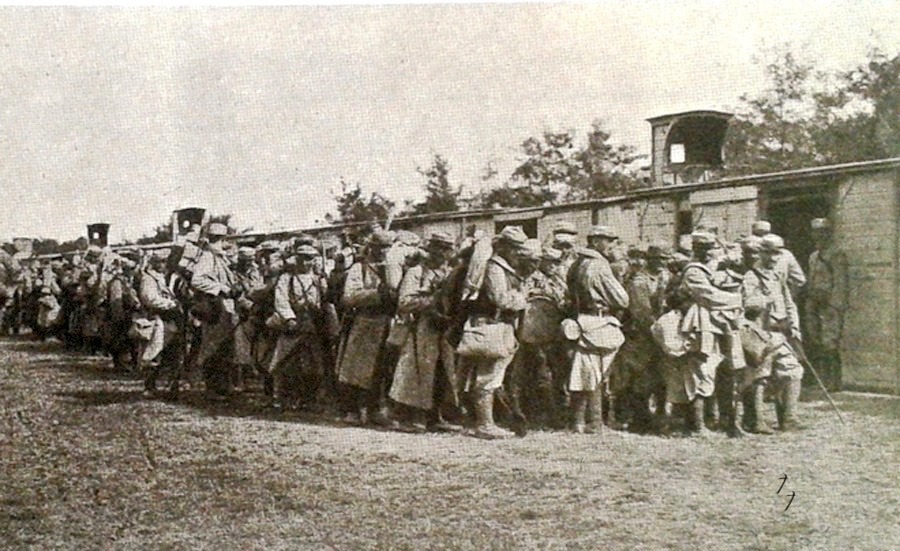
Greek soldiers boarding the train in Stavroupoli (photo source: f/b Old Photos of Xanthi)
On the morning of Friday, October 4th, 1919, the 9th Division arrived at the Xanthi railway station. The Greek general Georgios Leonardopoulos was welcomed by the Commander of Western Thrace, General Charles Antoine Charpy, together with his political advisor Charisios Vamvakas. After the honors were paid, the Liberators headed towards the square of Xanthi and entered the city from the North, from today’s IX Division Street, amidst celebrations. The head of the divisions, under the general’s orders, was the Xanthi engineer Lieutenant Gabriel Ladas. Evzon Georgios Tsikos from Arta raised the Greek flag on the mast of the Clock Tower in the square. At noon of the same day, with Xanthi sailing in a sea of Greek and allied flags and with the church bells ringing resurgently, the military parade began, marking the liberation of the city.
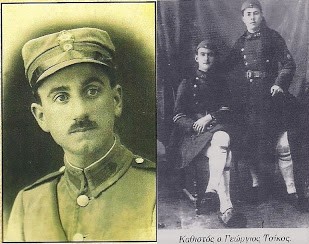
On the left is Gabriel Ladas, a reserve officer and later Mayor of Xanthi. On the right seated is the tsolias from Arta, Georgios Tsikos, who at noon on Friday, October 4, raised the Greek flag on the mast of the Clock Tower in the square. (Manolis Choumas Archive)
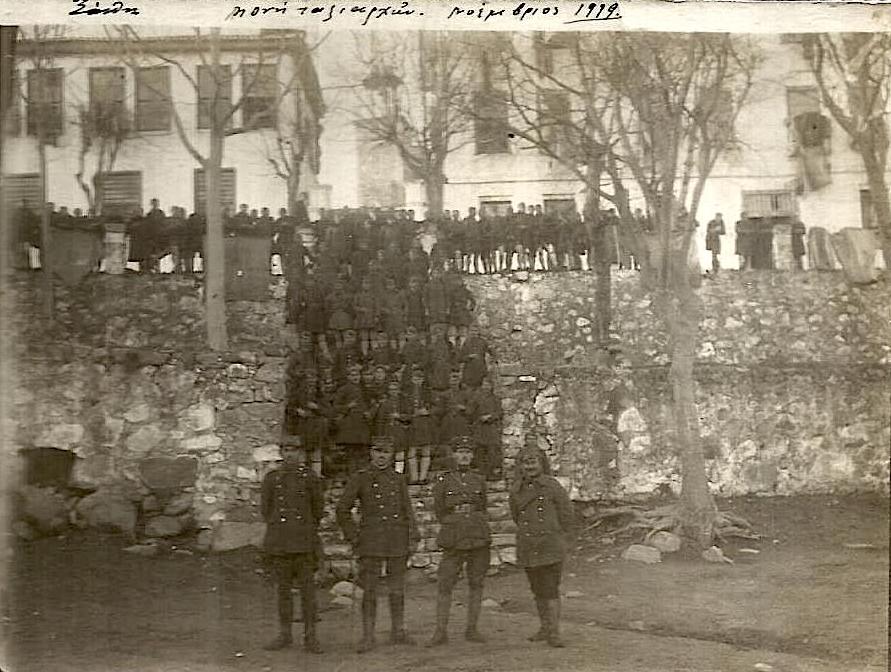
The Greek army at the Monastery of Taxiarches (source: f/b Old Photos of Xanthi)
After the liberation, Xanthi tried to get back on its feet and rebuild its economy. Very quickly (1922-23) the Asia Minor disaster brought to the land of Xanthi and all of northern Greece thousands of people uprooted from their unforgettable homelands of Pontus, Asia Minor and especially Eastern Thrace. The task of their rehabilitation was difficult and the struggles were hard. However, the refugees together with the locals managed to create Xanthi as we know it today. Once again, tobacco supported the first efforts, while at the same time refugee settlements were created in the plain that later flourished, such as Plastiria / Nea Kessani.
Among the refugees who arrived in the city and the surrounding area in 1922 were about 3,000 Armenians, who dynamically strengthened the small Armenian community of the city, whose presence dates back to the mid-19th century. Thanks to the wealthy Armenian tobacco merchant Takvor Takvorian, the community acquired a first place of worship and had its first financial support. From there on, the worthy and dynamic Armenians mobilized for the construction of a church and a school, the establishment of the “Armenian Youth of Xanthi” association and the creation of a Philharmonic Band, a football and theater team. In the economic and scientific fields, the Armenians of Xanthi, compared to their numbers, were distinguished for their achievements. Pharmacists, doctors, tobacconists, cloth merchants, goldsmiths, shoemakers, blacksmiths, each successful in their field, enjoyed prestige and esteem from their fellow citizens. (information from armenika.gr)
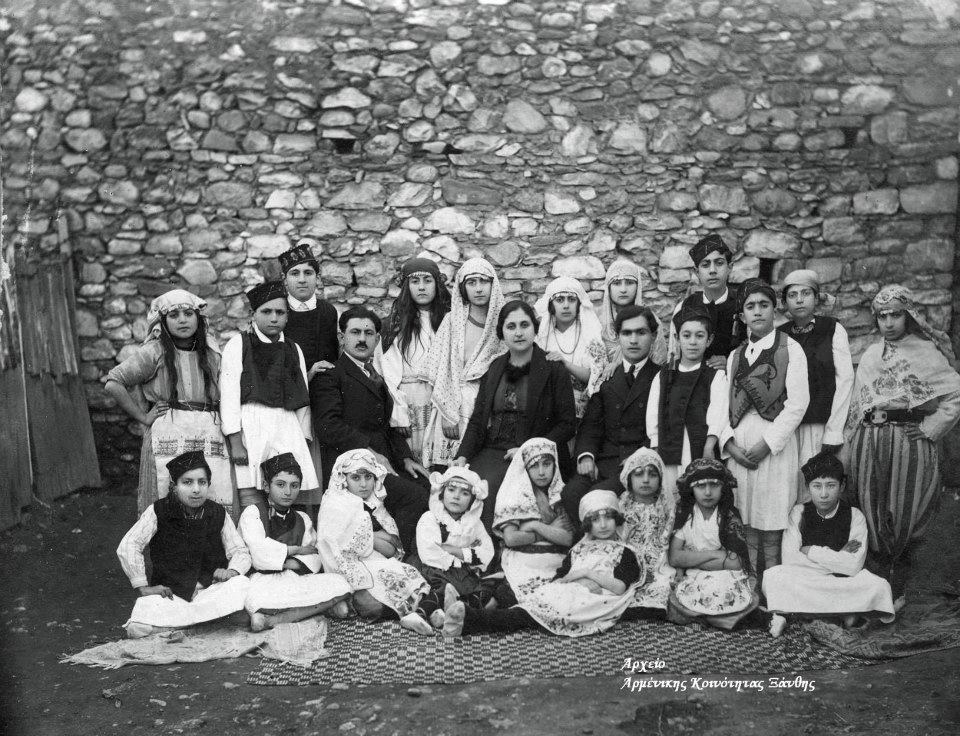
(Photo source: f/b Old Photos of Xanthi, archive: Armenian Community of Xanthi)
In October 1925, the leading Greek composer Manos Hadjidakis was born in Xanthi, the son of lawyer Georgios Hadjidakis (from Rethymno, Crete) and Aliki Arvanitidou (from Adrianople, Eastern Thrace). His father worked as a legal advisor for tobacco companies in the area and Manos lived in our city for the first 7 years of his life, until 1932, when he moved with his mother and sister to Athens. At the age of four, he began piano lessons with the Armenian pianist Anna Altounian. The house where Manos Hadjidakis spent his early childhood, built in the late 19th century with neoclassical elements and a bit of baroque, is now classified as a historical monument.
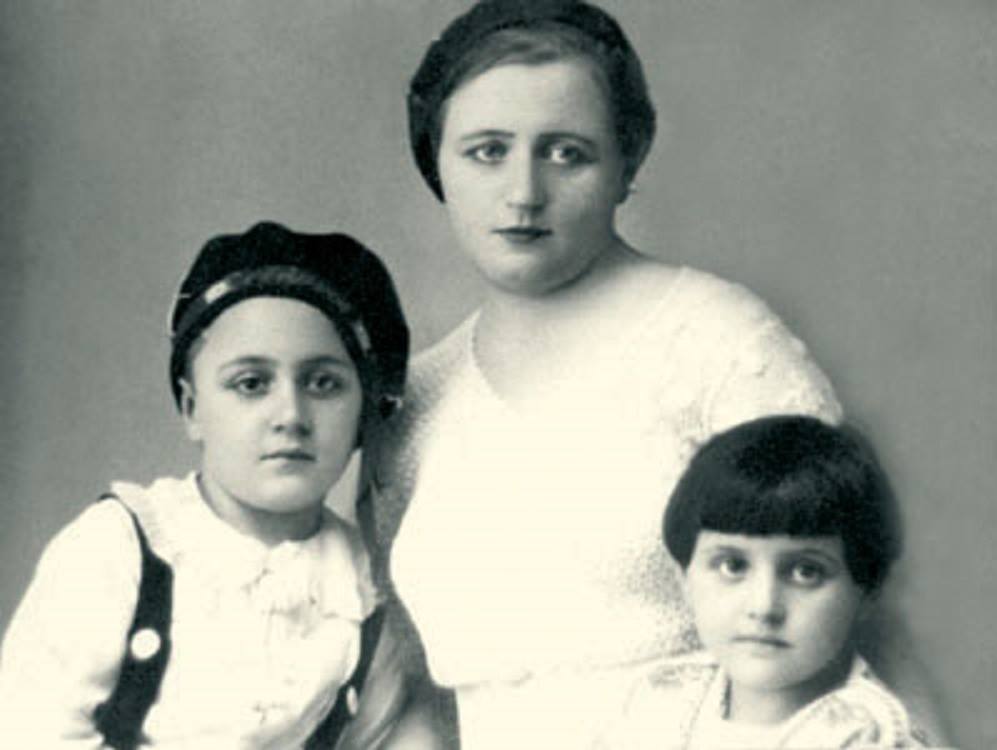 Manos Hatzidakis with his mother and sister in 1930 (Photo source: f/b Old Photos of Xanthi)
Manos Hatzidakis with his mother and sister in 1930 (Photo source: f/b Old Photos of Xanthi)
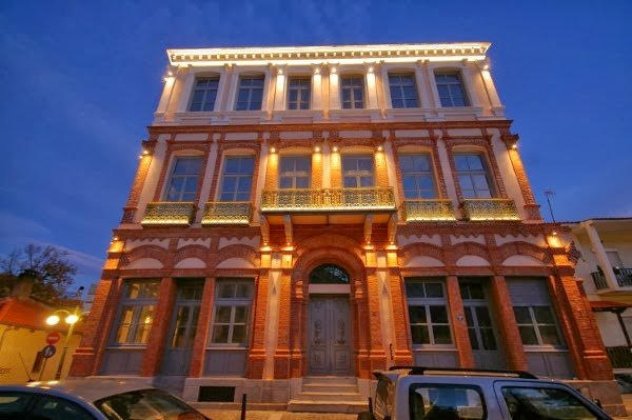
The Manos Hatzidakis’ house today, a multi-purpose space for art and thought (source: Municipality of Xanthi)
Because the tobacco trade certainly brought wealth to the city, but its production and processing was hard work and required many workers, during the interwar period the tobacco workers’ movement developed in the city, with the aim of protecting the numerous tobacco workers from the arbitrariness of the tobacco merchants. One of the “weapons” of their struggle was the bell they had in their union offices, which rang the end of the eight-hour workday and the end of the shift, greatly annoying the employers. In one of the turbulent and bloody demonstrations of the workers, the bell was arrested along with some of them, who were tried properly, convicted and served their 6-month sentence in the prisons of Komotini, becoming a world first!
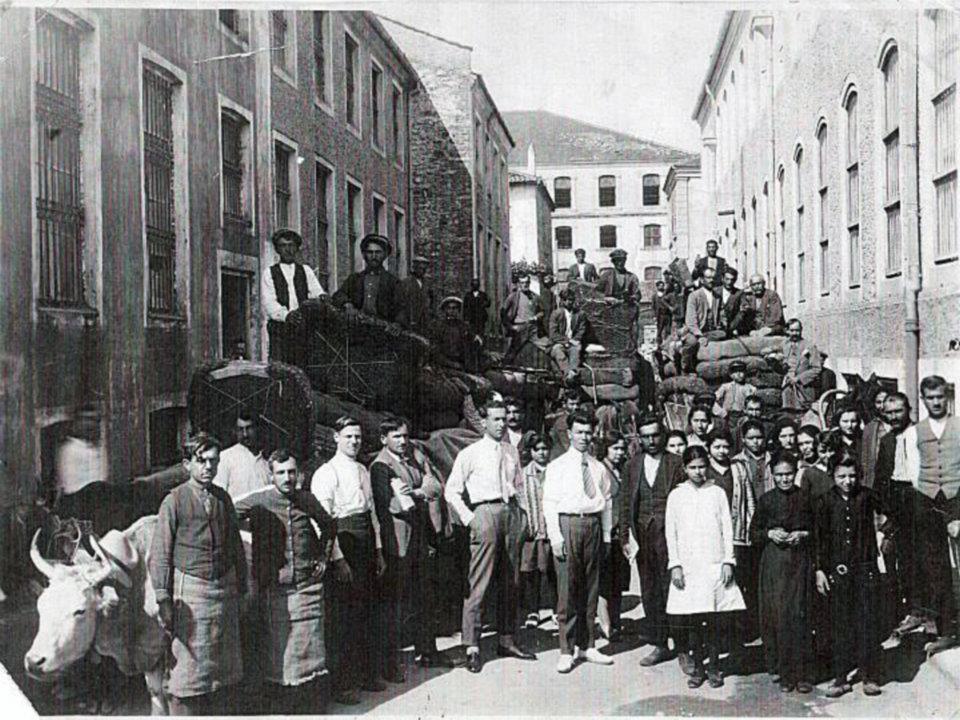
Tobacco workers, men, women, even children (Source: f/b Old Photos of Xanthi)
Despite all the adversities, this period throughout Greece was filled with optimism for the future. However, the development of our country and city was interrupted by World War II. On October 28, 1940, the sirens of war sounded fiercely in Xanthi as well. The people of Xanthi willingly followed the harsh fate of those who love peace, but must defend their land from the violence of those who consider themselves strong.
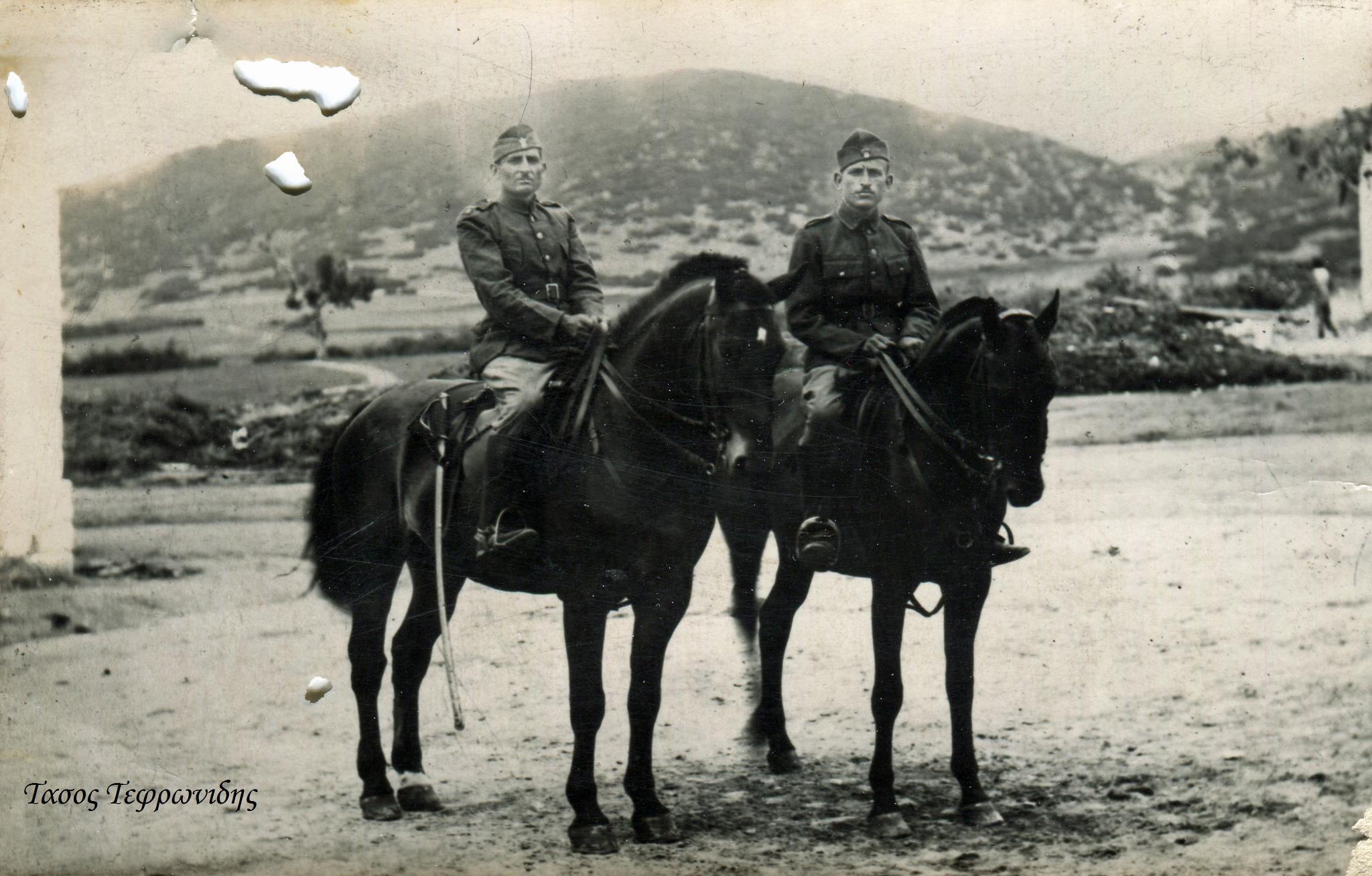 Xanthi soldiers in 1940 (source: f/b Old Photos of Xanthi)
Xanthi soldiers in 1940 (source: f/b Old Photos of Xanthi)
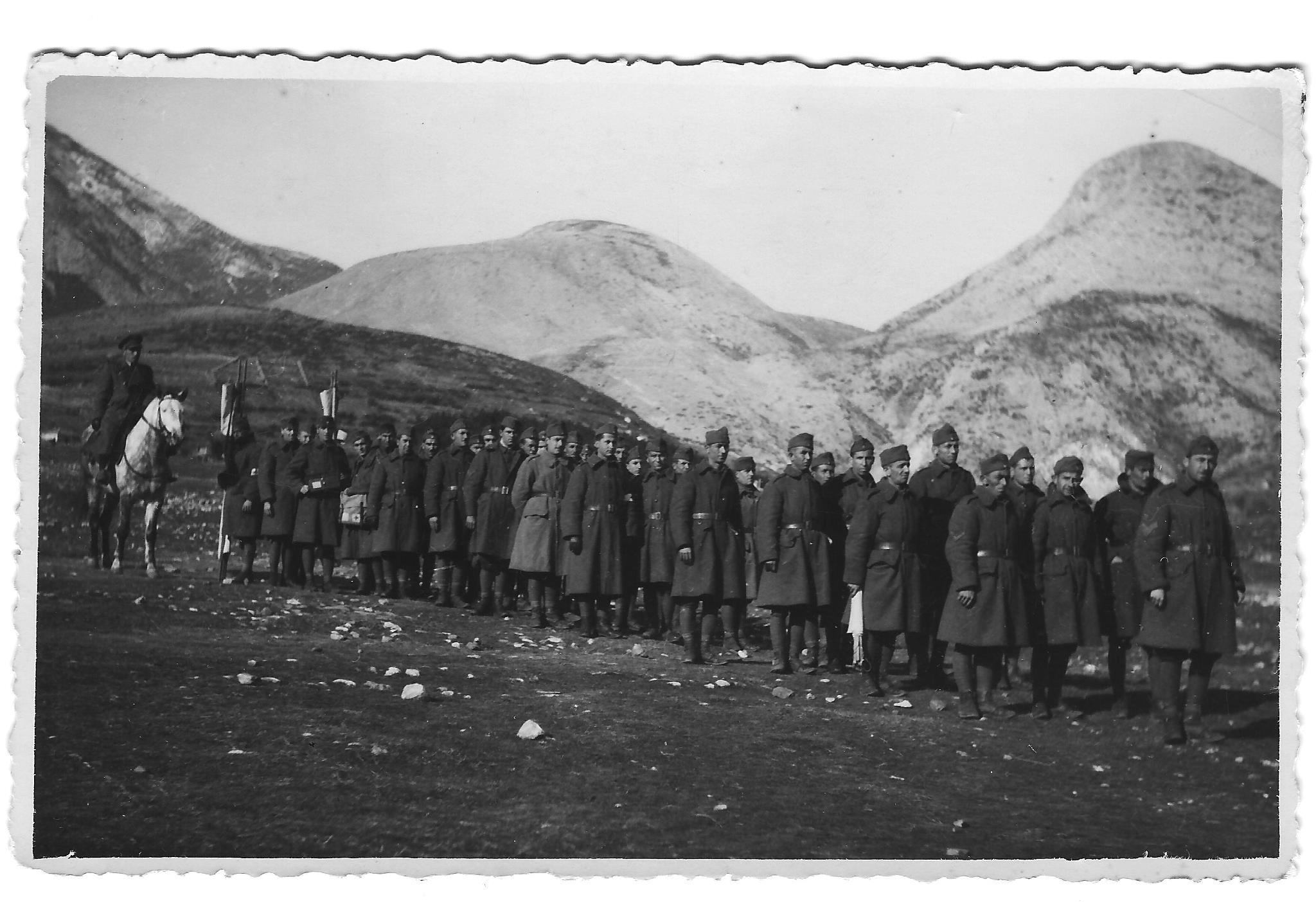
The Greek army, therefore, with unique heroism, fought hard and victoriously against the Italians in Epirus. Thus, Hitler, from November 1940, decided that he himself had to attack the unruly Greece. In March 1941, Bulgaria also joined the Axis with the tempting promise that it would occupy the whole of eastern Macedonia and western Thrace. On March 9, the German army reached the Greek-Bulgarian border.
For their effective defense, 21 forts had been built along our northern border from 1936 to 1940. They are known as the “Metaxas Line”. Their design had been done exclusively by Greek officers and this defensive line was superior to other similar ones in Europe. The so-called Battle of the Forts took place in these forts between 6 and 9 April 1941. The last two forts that interest us are the forts of Echinos in Xanthi and Nymfaia in Rhodope. Their mission was to halt the advance of German forces towards Komotini and Xanthi and to provide cover for the Greek military forces at Nestos.
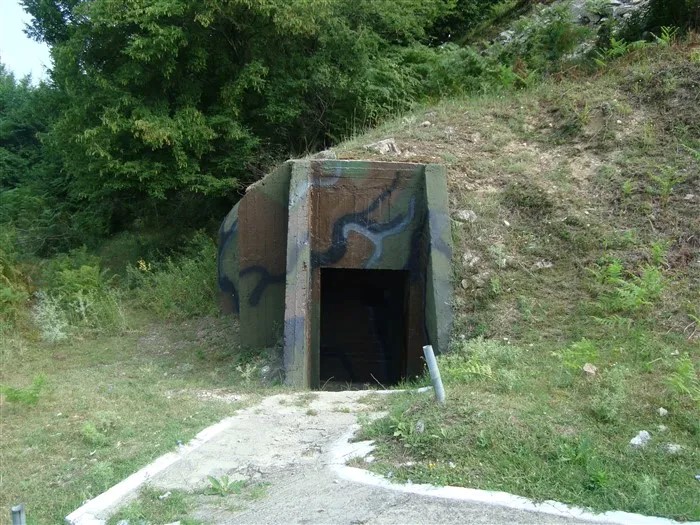
Echinos Fort (Source: metaxasline.org)
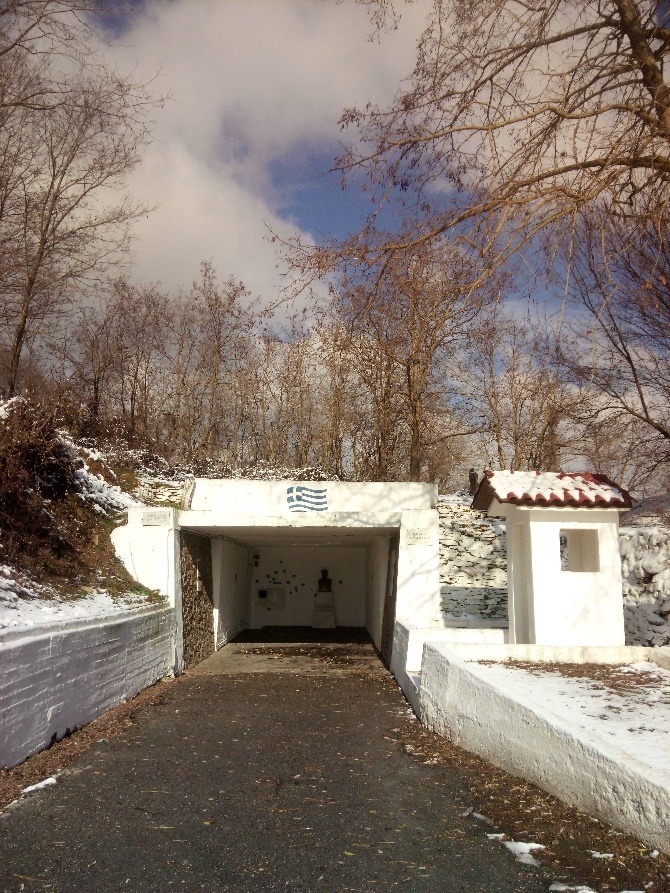
Nymfaia Fortress (source: army.gr)
The fort of Echinos consisted of 4 large buildings. Its defenders were 20 officers and 645 soldiers, Christians and Muslims. After fierce fighting, in which the Germans lost about 200 men (without any Greek losses), on the morning of April 8, the Germans hit the M complex of the fort with heavy bombardment and after hand-to-hand fighting they invaded its galleries. Later, they managed to throw asphyxiating gases into the air ducts of the other buildings. At night, the fort was evacuated in an orderly manner and the fort’s garrison withdrew to Kentavros, where the residents of the area were gathered. There they were informed that the cities of Xanthi and Komotini had fallen into the hands of the Germans. After this, the garrison was forced to surrender. In the village of Echinos, the men were welcomed by the commander of the German division that had attacked them and congratulated them with the words “You are a brave army and worthy of better luck.”
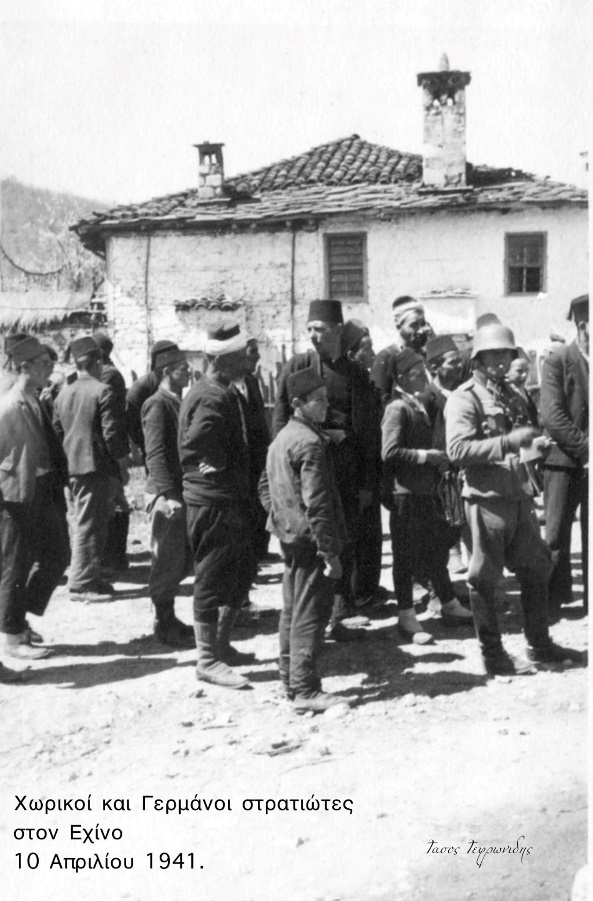
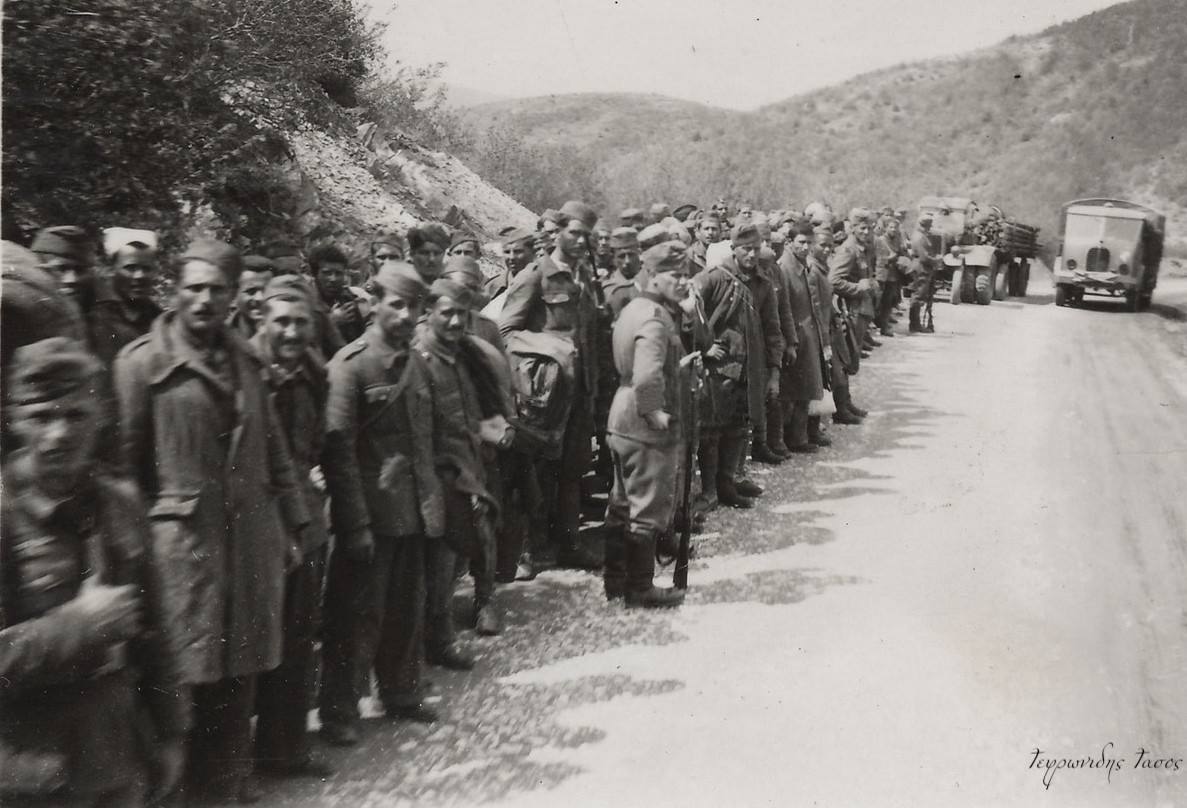
In the second photo, Greek prisoners. Photo source: f/b Old Photos of Xanthi
And so the Germans managed to enter Thrace and Xanthi.
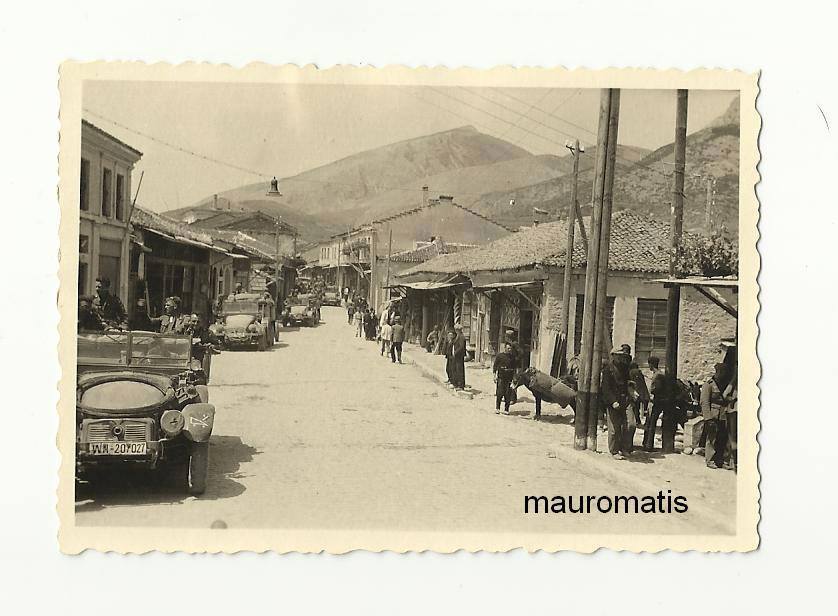 Source: f/b Old Photos of Xanthi
Source: f/b Old Photos of Xanthi
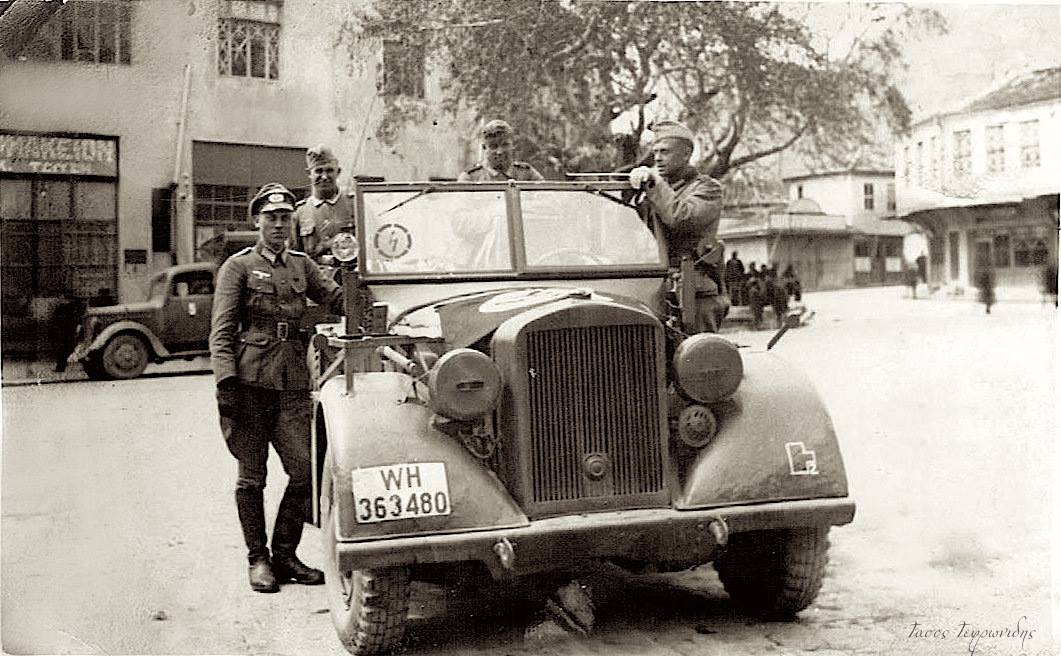
German soldiers in the central square of Xanthi (Old Photos of Xanthi)
The period of German occupation was very short and was not marked by any significant events. The political administration continued to be exercised by the Greek authorities. However, from the end of April, with the permission of the Germans, the first Bulgarian troops appeared, while on May 11, with a festve ceremony, the Germans handed over eastern Macedonia and Thrace to the Bulgarians and began to withdraw.
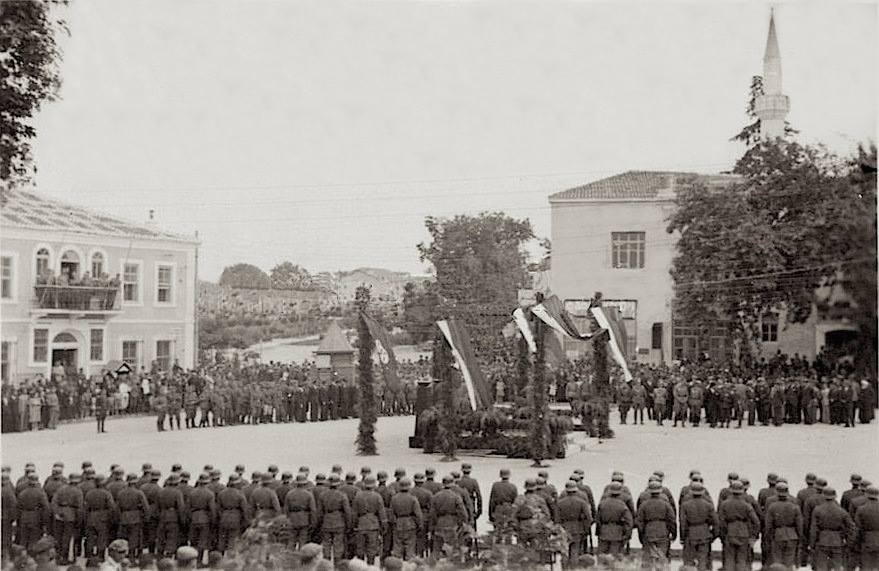 City handover ceremony in the central square (f/b Old Photos of Xanthi)
City handover ceremony in the central square (f/b Old Photos of Xanthi)
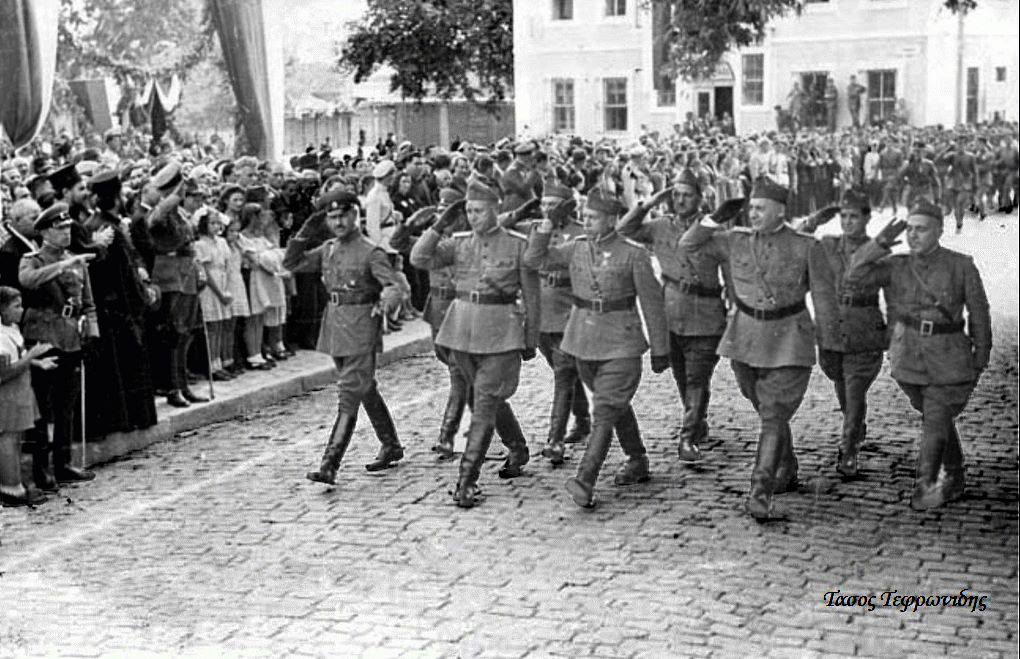
Bulgarian soldiers marching in the city center (source: f/b Old Photos of Xanthi)
The Bulgarians forcibly occupied public buildings, expelled all Greek employees and took over the administration. At the same time, the ambitious plan of Bulgarization of the region was put into effect.
1. An order was given to equip all shops and houses with Bulgarian flags,
2. Bulgarian was determined as the official and only language of communication with the authorities, as well as on the signs of shops and streets.
3. All Greek schools were closed, in their place Bulgarian would operate.
4. All churches had to operate in Bulgarian.
5. A permit was required for every movement.
6. Traffic was prohibited from 10 p.m. to 8 a.m.
Also, metropolitans, scientists, intellectuals and in general those who could influence the population due to their education and prestige were deported to German-occupied Greece. The properties of those who had taken refuge in the rest of Greece were confiscated and only those who declared that they were of Bulgarian origin upon returning saved their belongings. In November 1941, exterminating taxes were imposed, while several were forced to “donate” their properties to the Bulgarian state. In addition, food, agricultural production and large animals were requisitioned for the needs, as they said, of the Bulgarian army. The people of Xanthi were very hungry, since only those who declared themselves Bulgarians to the authorities had access to food. It is shocking to hear that some people walked as far as Porto Lagos, 30 km away, to sell whatever valuables they could in the villages of the plain, where there was still little food. At the same time, the effort to settle Bulgarians in Thrace began, with the aim of changing the composition of the population. Thus, families came from Bulgaria (5,000 in Xanthi) and settled in houses that had been requisitioned.
The dourdouvakia: They were soldiers, not combatants, but essentially hostages of the Bulgarian army – workers in the forced labor battalions. Bulgaria needed cheap labor for some public works, such as opening roads. The easiest thing to do was to forcibly recruit the occupied Greeks of Thrace, which they did. The durduvaks worked for 10 hours with poor food, and if they weren’t young and strong, they wouldn’t have been able to withstand the fatigue, the cold, and the beating.
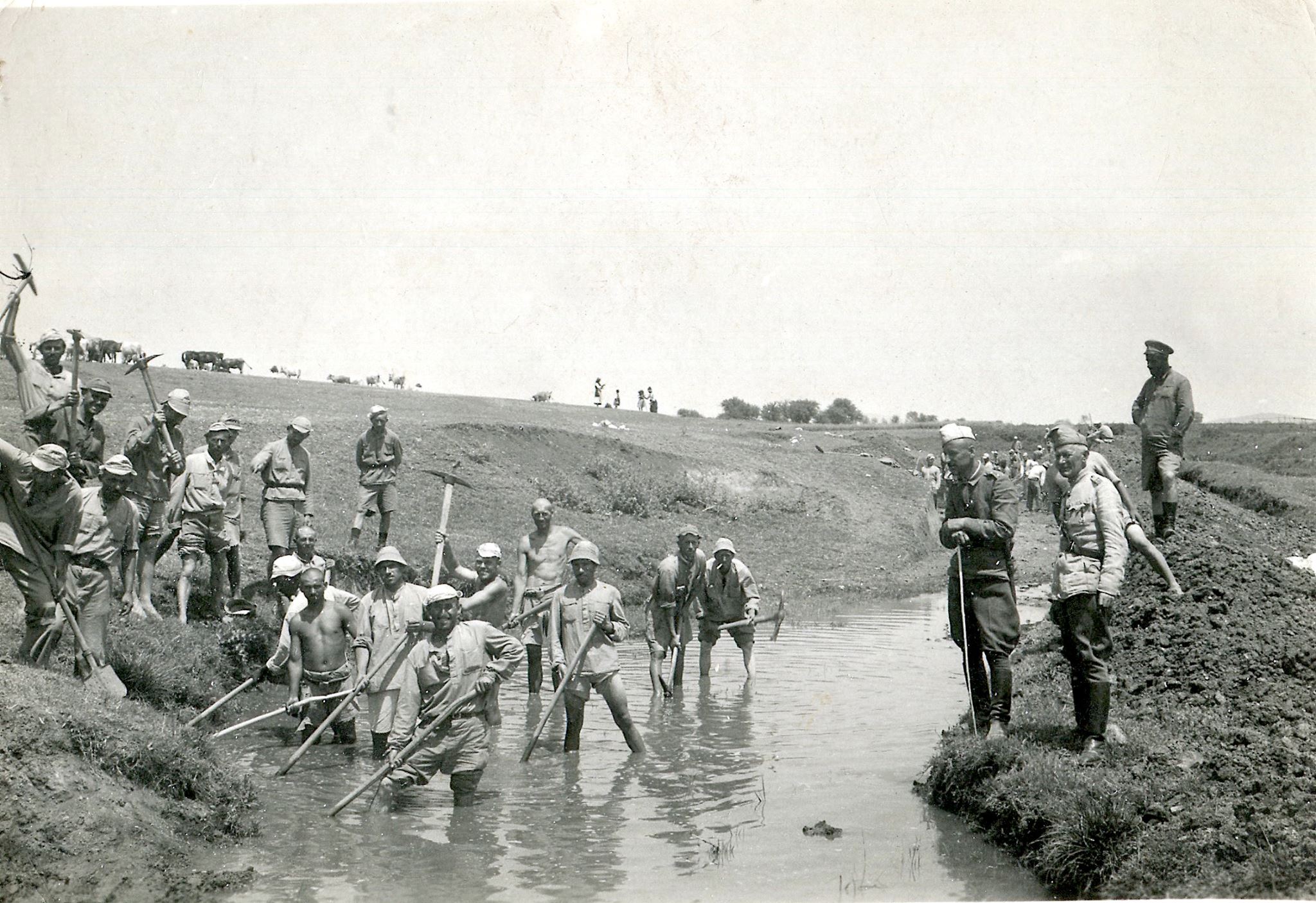
Thracians in forced labor in Bulgaria (source: f/b Old Photos of Xanthi)
Another aspect of Xanthi’s history that is not particularly well known is the presence of the city’s Jewish community. The time of their settlement here is not known, but according to data from the “Consular Archives of Thrace” in 1907 the “Israelite Community of Xanthi” was established with 234 members, who were descendants of Spanish Jews – Sephardim and spoke the Spanish-Jewish dialect “Ladino”. Most of the Jewish residences were located in the degraded area “Pournali” / “Pournari” which is today called “Remvi”. The wealthier Jews lived in the “Upper Town” (Old Town) and were involved in the tobacco trade. The community had a Synagogue, a Club, a community center and a Jewish school, published three publications in the Ladino language and was generally very active. In 1934 the Jews of Xanthi numbered 1,100, but before World War II they were reduced by half due to immigration within and outside Greece.
The fate of the Jewish community of Xanthi was tragic, like that of millions of other Jews throughout Europe. During the occupation, on the night of March 3-4, 1944, the Bulgarians, faithfully implementing the organized plan of the “final solution” of their German masters, unexpectedly arrested the approximately 550 Jewish residents of Xanthi and gathered them in a tobacco warehouse. That night, only one escaped, by sheer luck, Juda Haim Perahia, who was in Kavala on business. Two weeks later, their transport through Bulgaria to the crematoriums of Treblinka began, where they met a tragic death. The Bulgarians looted Jewish homes and shops and encroached on property. Of the Jews of Xanthi, very few survived and they never returned; thus the destruction of the Community was complete. (information from Manolis Choumas and the website www.kis.gr)
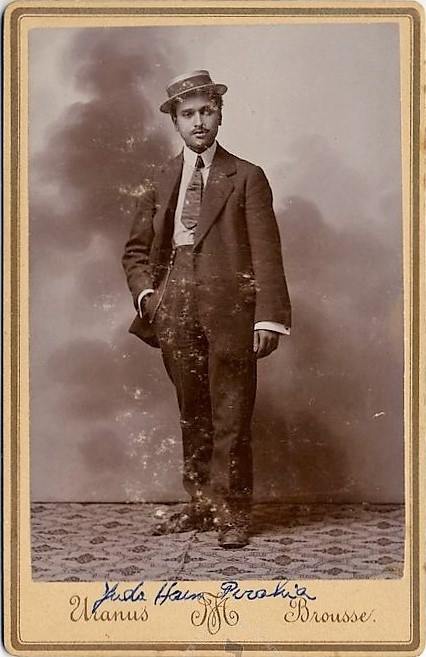
Juda Haim Perahia in a 1911 photo in Prussa
(source: f/b Old photos of Xanthi, by Manolis Choumas)
By mid-1944, it seemed that the Axis powers, which had bled Europe, had been defeated. The Soviet army arrived in Bulgaria, the fascist regime collapsed and it was transformed into a communist state. The Bulgarian troops were forced to abandon our region in October 1944 and the administration of the free Xanthi was taken over by the ELAS guerrilla forces, until March 1945.
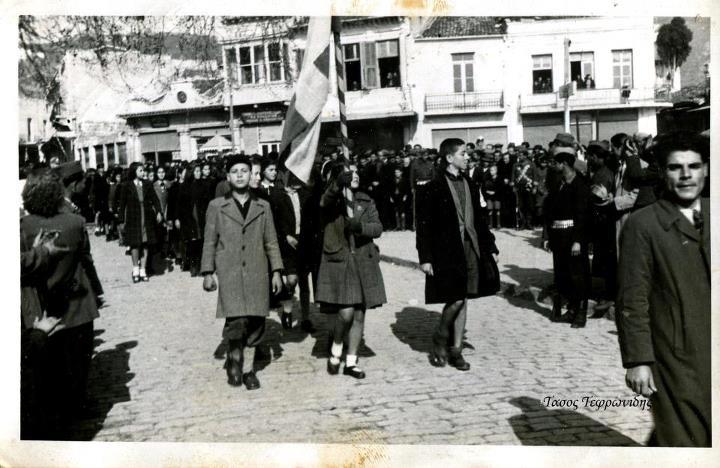
Children of the 1st elementary school marching for liberation in 1944 (source: f/b Old Photos of Xanthi)
After the long and bloody civil war, our Xanthi followed the course set by the policies of the governments of our country, going through various phases. The development of the agricultural cooperative movement and cooperative factories was very important thanks to the great work of the Xanthi politician Alexandros Baltatzis (a refugee from Pontus), which strengthened the economy of our country, when the tobacco trade had definitively lost its former glory. Unfortunately, little remains of this great effort, due to the disastrous economic policies of Greece, but also of Europe, in combination with the economic crises that hit our country.
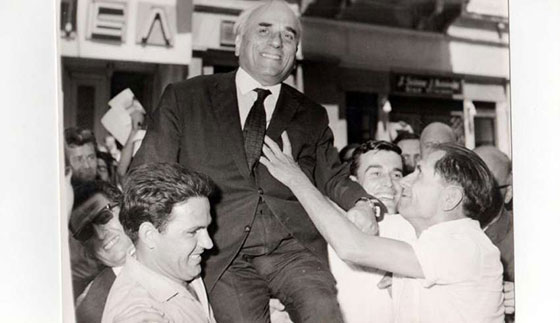
Source: Xanthinews.gr
Milestones in the history of our city are the establishment of the Polytechnic School in 1973 and the reconstitution of the 4th Army Corps in 1976, which strengthened its economy and population. Also very important was the abolition of the regime of the supervised zones and the “throwing down of the bar” in 1995, which freed the residents of the mountainous Pomak villages of our prefecture from the restrictions that existed and which, by common admission, were detrimental to our national interests.
We call the villages of mountainous Xanthi Pomaks, with the most representative villages being Myki, Echino, Kentavro, Melivoia, Thermes, Kotyli, Satres, Pachni, Kottani. The Pomaks have lived in Thrace in the Rhodope Mountains for thousands of years and are probably descendants of the ancient Thracian tribe Agrianes. Their language is a local dialect, based on Greek but with a very strong influence from the Bulgaro-Slavic language. During the Ottoman period, many Turkish words related to religion, courts, administration, etc. entered the Pomak language.
The Pomaks were Christians until the end of the 17th century, when they converted to Islam, 300 years after the Ottoman conquest of Thrace, but they maintained some Christian customs and traditions, such as the celebration of the memory of Saint George or the crucifixion of bread (at least by the older ones). Unfortunately, the Pomaks fell victim to the Cold War, which to a large extent influenced (if not determined) the policies of Greek governments during the 20th century. Although the Pomaks had a Greek national consciousness, in 1954 the Greek government by law recognized the minority schools in the Pomak villages as “Turkish”, which was ratified in 1972 during the Junta, when the relevant signs were replaced. And this, in order to distinguish the schools and by extension the villages on the Greek side from the corresponding Pomak Muslim ones on the Bulgarian side that had a communist regime! And the regime of the supervised zones that made the residents of mountainous Xanthi second-class citizens for many years worsened the situation even more and allowed the Turkish state to freely weave its revisionist plans in Thrace. In any case, today the facts have changed and the Greek Pomaks of Xanthi, Muslims by religion, have formed a strong and dynamic community, they observe and promote their traditional customs and live harmoniously with the other ethnic groups of our country.
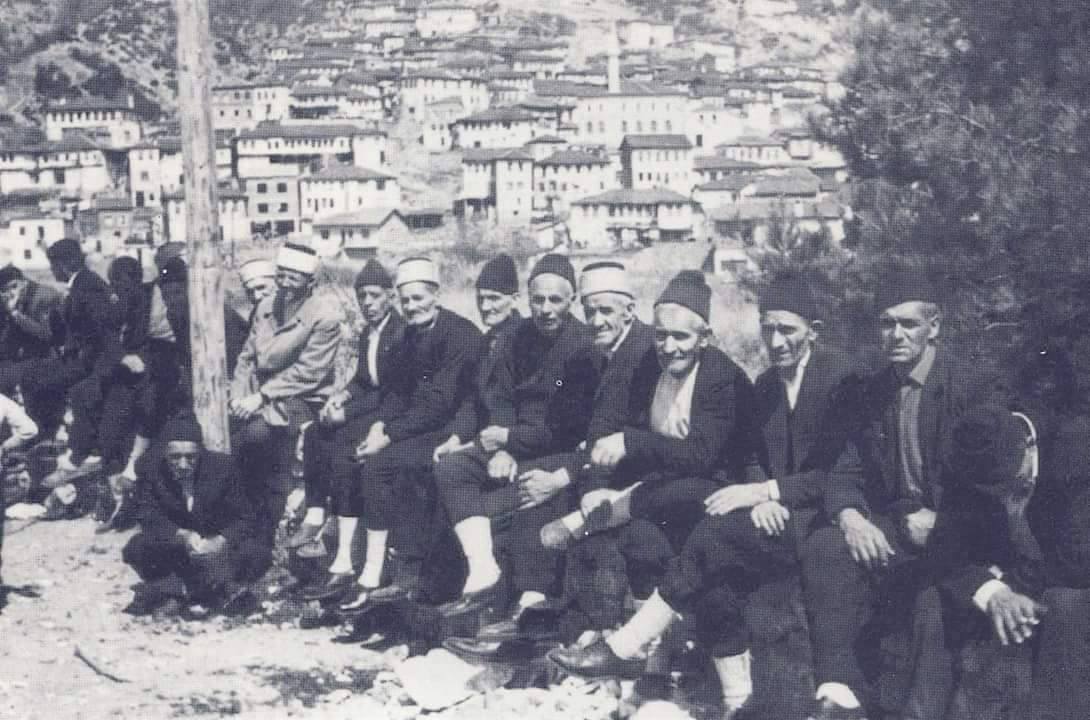
Elderly people in the village of Echinos in the 1960s (source: f/b Old photos of Xanthi)
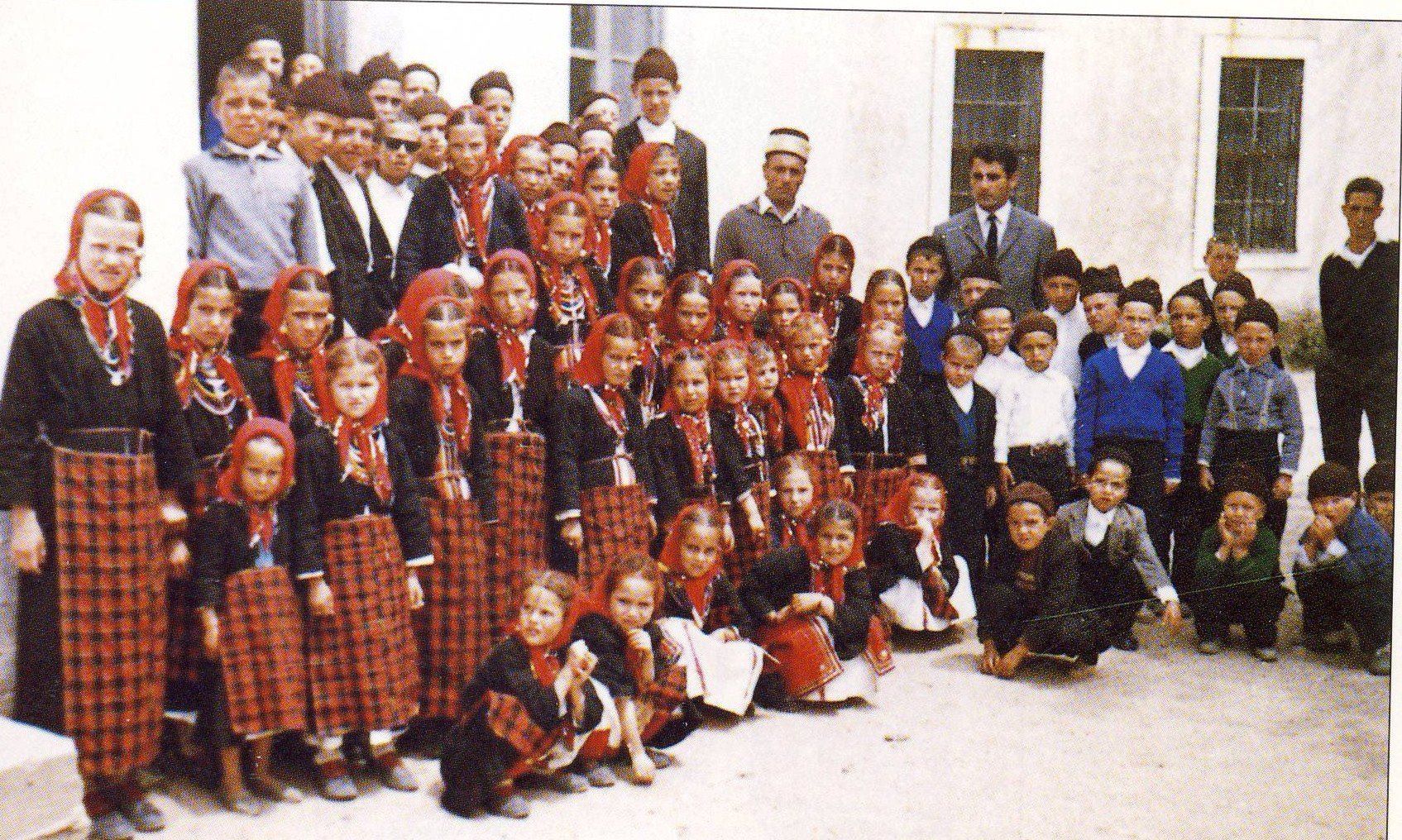
The students of Sminthis Primary School in their traditional costumes in 1967 (source: f/b Old photos of Xanthi)
The 1990s were a period of great growth for Xanthi, with the expansion of the urban section of thw city and the explosion in construction, but mainly with the work of Mayor Philippos Amiridis, the reformer of Xanthi as he is called. F. Amiridis carried out major infrastructure projects and successfully promoted the city’s cultural institutions, building a rich future for our Xanthi. His sudden death in 1999 plunged the city into mourning and since then the people of Xanthi have honored his memory at every opportunity.
 Photo source: paratiritis – news
Photo source: paratiritis – news
Today Xanthi is a commercial and cultural center of the region, with a population of 108,195 in the Regional Unit and 66,875 in the Municipality of Xanthi. The composition of the population is rich and interesting, as it consists of Greek and Armenian Orthodox Christians, Greek Muslims, who are divided into people of Turkish origin, Pomaks and Roma, as well as economic immigrants of Bulgarian, Albanian and even Chinese origin. The Christian population of the city was strengthened on two occasions: in 1922 with the settlement of many refugees from Asia Minor and Eastern Thrace, as well as during the 1990s with the arrival of Pontians repatriated from the countries of the former Soviet Union. Thus, one of the special features of our city is its multiculturalism and the harmonious coexistence of the Christian and Muslim elements. A characteristic example of this multiculturalism is the corresponding linguistic diversity of the population. In the bustling streets of Xanthi one can hear Greek, Pomak, Turkish, Russian, Bulgarian, etc. The joy of the linguist, we would say!
At the same time, the uniquely beautiful Old Town, shops, squares, parks, entertainment centers such as cafes, restaurants, taverns with wonderful aesthetics, world-famous pastry shops, attract locals, but also tourists from Greece and abroad. Of course, the natural beauties of the prefecture are also a magnet for tourists. The beautiful suburban grove of the city, the Tempi of Nestos and the impressive meanders of the river, the Livaditis waterfall, which is the largest in the Balkans, the internationally protected wetland of Lake Vistonida with its unique flora and fauna, the sandy beaches of the Thracian Sea (Ai Giannis, Maggana, Erasmio, Myrodato, etc.), all this unique biodiversity can satisfy the interests of every visitor.
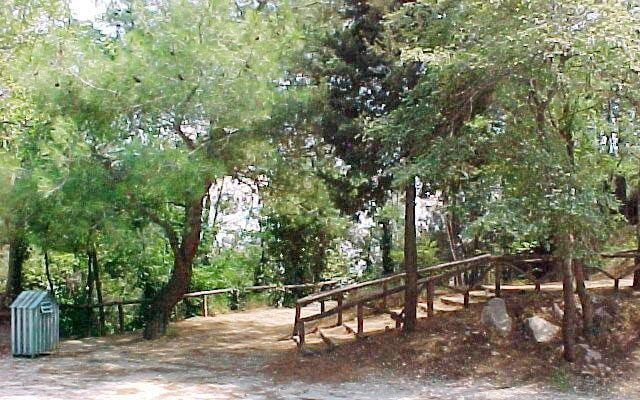
The suburban grove of Xanthi (photo source: www.thraki.com.gr)
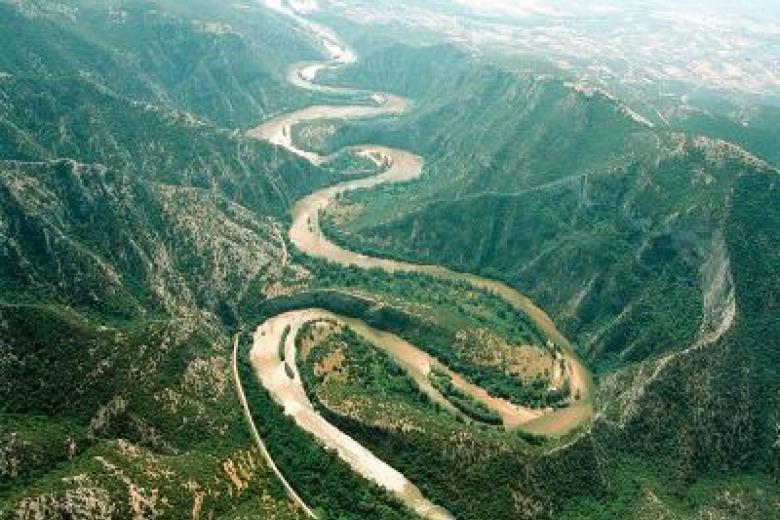
The meanders of the Nestos River (Photo source www.imerisia.gr/travel)
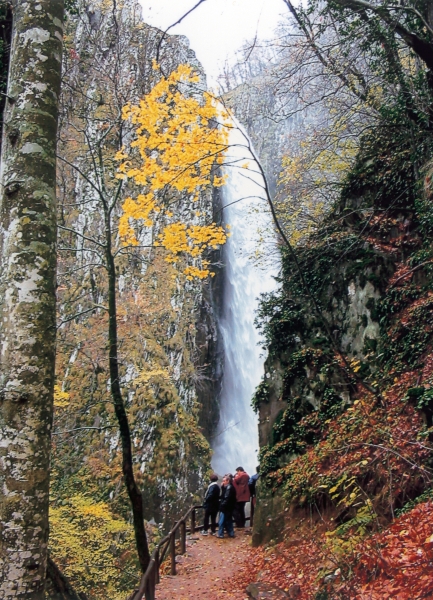
The Livaditis waterfall (source: Municipality of Xanthi)
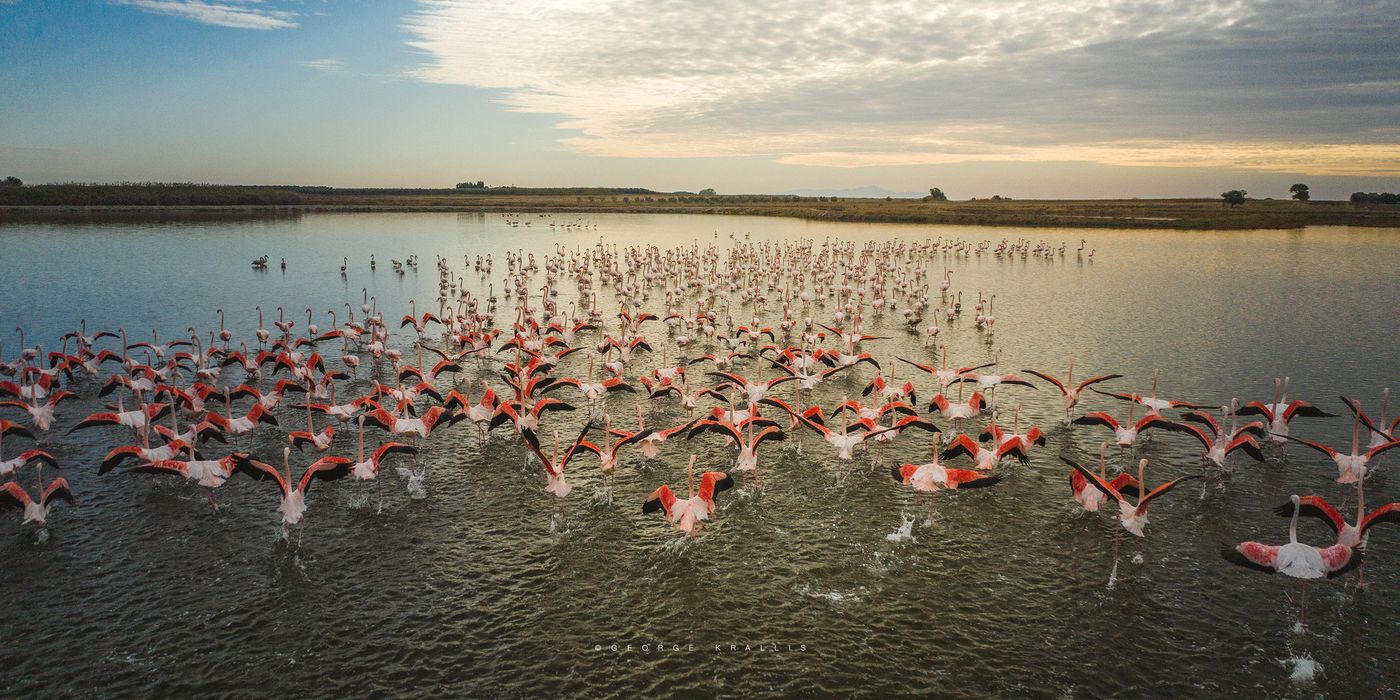
Impressive flamingos at Lake Vistonida (source: Municipality of Xanthi)
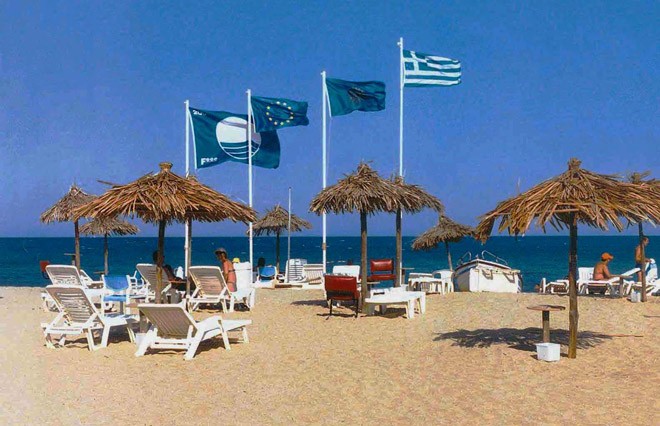
One of the beautiful beaches of Xanthi (source: xanthinews.gr)
Xanthi is also a popular place for the quality of its residents. Kind, generous, outgoing, authentic, open-minded people help every visitor or new resident (student, military, worker) to feel familiar and comfortable in a city with a human rhythm of life and many interesting things to see and do. The people of Xanthi love celebrations, good food, drink and good company. On summer evenings, the alleys of the old town are bustling with life, youth and beauty and one thinks that one is in an island tourist resort, on Sundays the taverns are suffocatingly full and on Saturday mornings the usual combination is shopping at the famous open-air bazaar and then a coffee in one of the squares or pedestrian streets of the city. Here we should note that the history of our bazaar is lost in the years of the Ottoman period. At times it functioned as a livestock market or as a market for fruit and vegetable producers, while today one can find everything, from excellent quality food to clothes, shoes, books, tools and much more. Until 1920 the bazaar was held in today’s central square, every Sunday. The Xanthi bazaar has a special color, which one will not encounter in other open-air markets.
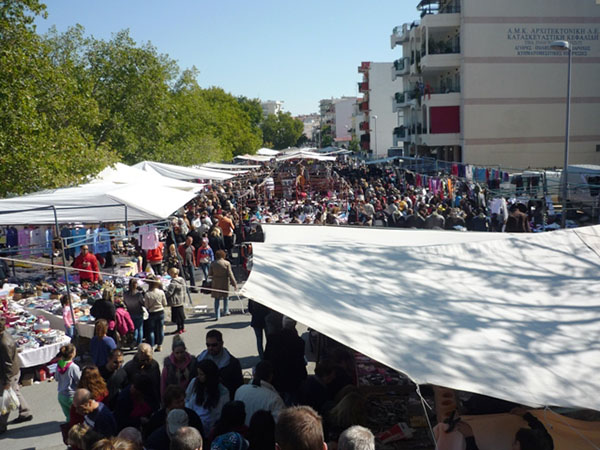
The cultural life of the city is also rich and interesting. Of course, the best known are the Xanthi Carnival – the Thracian Folklore Festival, the Old Town Festival, unique in its kind and famous for its diverse events, the wonderful Festival “Xanthi City of Dreams” of Music Schools dedicated to Manos Hadjidakis, as well as many other institutions related to sports, tradition and art, for the realization of which various cultural associations and other bodies are laudably active.
Carnival – Thracian Folklore Festivals
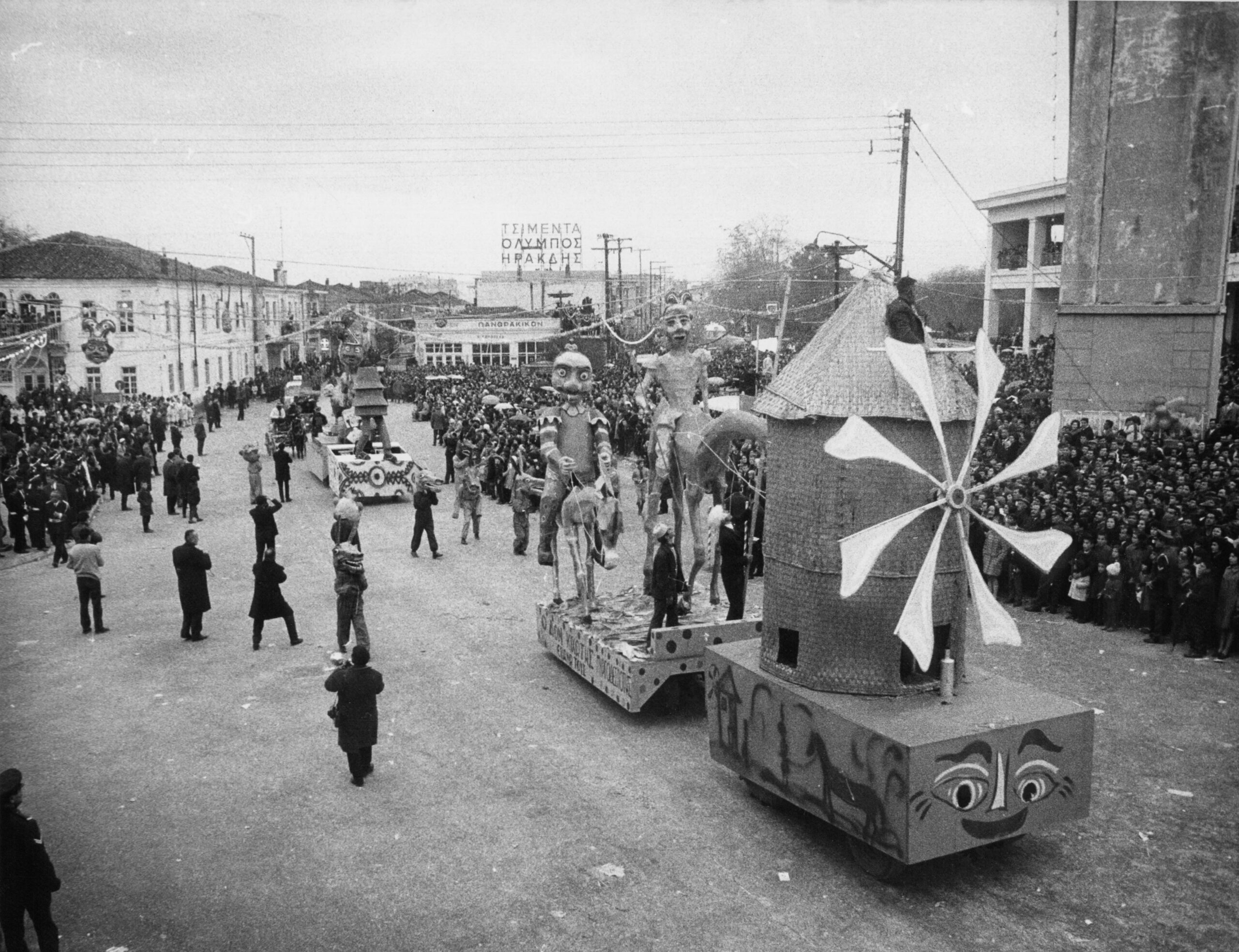
Carnival parade – 1960s (photo source: cultureofxanthi.gr)
The history of the Xanthi carnival begins when, for the first time in 1966, a group of Xanthi residents, the Local Tourism Committee, with imagination, enthusiasm and courage, promoted the idea of holding folk festivals during Carnival. The goal was the national, spiritual and cultural development of the prefecture of Xanthi and at the same time the contribution to the local economy. Thus, the “Carnival Thracian Festivals” were organized. They lasted a week and were held in the central square, while on the last day a procession of carnival floats crossed the main streets of the city. The participants and the organizing committee tried to revive customs of Xanthi itself, Thrace, but also to incorporate Pontic and Asia Minor traditions into the festival. The success of the first Thracian Festivals exceeded all expectations. That is why the following year the events were repeated. In fact, in 1967 they lasted two weeks, were better organized and had a greater variety of themes. In the years 1978-1979 an attempt was made to “marry” the past with the present, with particular emphasis on the participation of traditional dance groups, Greek and foreign, the appearance of philharmonics, choirs, karagiozis performances and the organization of exhibitions.
In 1991 the municipality of Xanthi, with the late mayor Philippos Amoiridis and with the participation of cultural associations, city organizations, people of letters and arts, undertook the organization of the Thracian Folklore Festivals with the aim of coordinating and generally planning the events. The preparation time increases, the fifteen-day celebration is established, as well as the dances of the clubs and the theatrical and musical events with famous artists. The phantasmagorical element is introduced with the colorful presence of carnival groups – especially in the parade on the last Sunday. The stigma of the Xanthi carnival is maintained with the entrance, as always, of the Thracian Carnival at the beginning of the festivities and the “Burning of the Tsar” in a phantasmagorical event at the end of the Carnival, which is revived every year on the bridge of the Kosynthos River. (the text comes from the site odigosxanthis.gr)
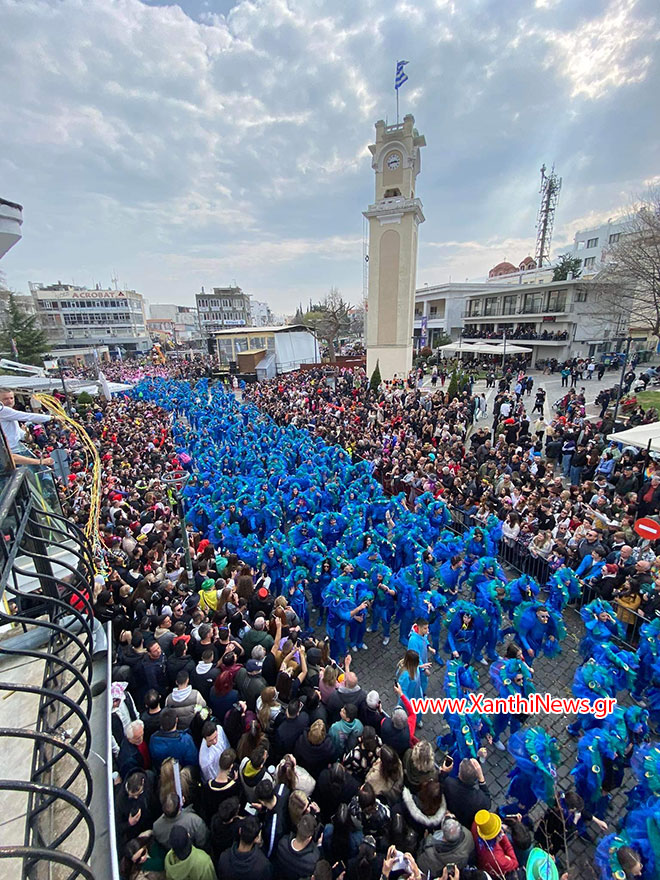
Xanthi Carnival (source: xanthinews.gr)
Old Town Celebrations
The Old Town Festival of Xanthi is the second largest institution, after the Xanthi Carnival. They were first organized in 1991 and have taken place every year since then in the first week of September. They took their name from the traditional preserved settlement of Xanthi, the “Old Town”, in the paved streets and neighborhoods of which cultural associations settle and organize festivities with live music, food and drink.
In 1991, the newly elected Mayor Philippos Amiridis was looking for an institution to highlight the Old Town of Xanthi. He found allies in this effort in Nikostratos Foteli, a painter of the “Friends” association, the “Campers” Association and the Pontian Association. Initially, there was the idea of organizing a Belle Époque revival with events, period costumes and a traditional character, as it turned out. At the same time, the “Campers” also proposed the active participation of the public, and thus the setting up of the first two stands by the “Campers” and the “Friends” came about. Over time, the organization evolved and became established, becoming a destination for several of the country’s greatest artists. The epicenter of the events is mainly Mitropoleos Square, around which the clubs and the concert venue are located. (the text comes from el.wikipedia.org)
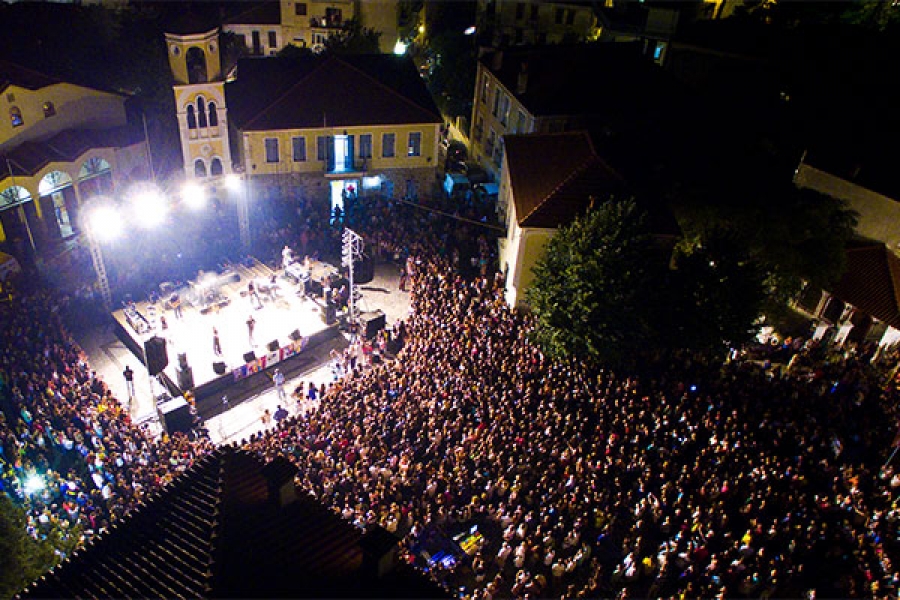
Old Town Festival (source: odigosxanthis.gr)
Festival “Xanthi, City of Dreams of Music Schools”
Since 2014, the Xanthi Music School has been co-organizing the Festival “Xanthi, City of Dreams of Music Schools” together with the Municipality of Xanthi and the Cultural Center of the Municipality, dedicating the institution to the memory of our leading composer Manos Hatzidakis. Every spring, dozens of music schools from Greece and abroad are invited and for a few days the city is filled with hundreds of talented young musicians, wonderful melodies, youth and beauty! The highlight of the events is the closing ceremony with the short in duration, but magnificent in participation and emotion, concert under the direction of the great composer and conductor Nikos Kypourgos. Kypourgos miraculously manages to coordinate over 1000 student musicians to play a few, but wonderful pieces of music accompanied by the also large choir, wonderfully led by Erifilli Damianou. Every year the concert closes with the wonderful song “A Magical City” to music by Manos Hatzidakis. This festival is truly the most beautiful celebration of our city!
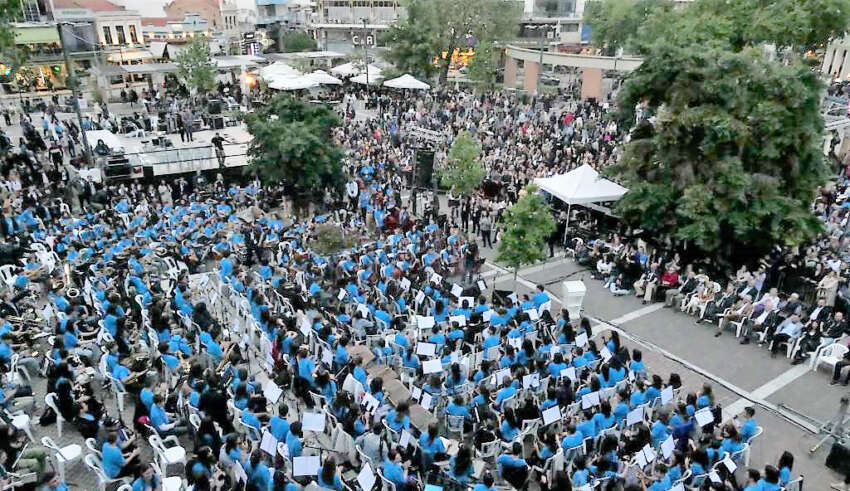
Music Schools Festival (source: Embros electronic newspaper)
I think that we, the people of Xanthi, can rightly be proud of both the past and the present of our city!
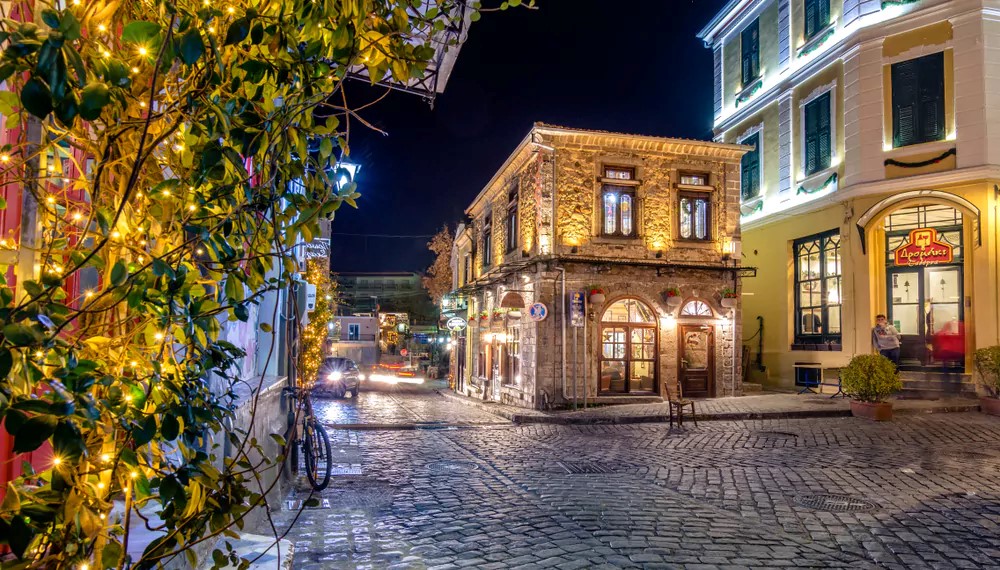
Xanthi at night (source: OutNow.gr)
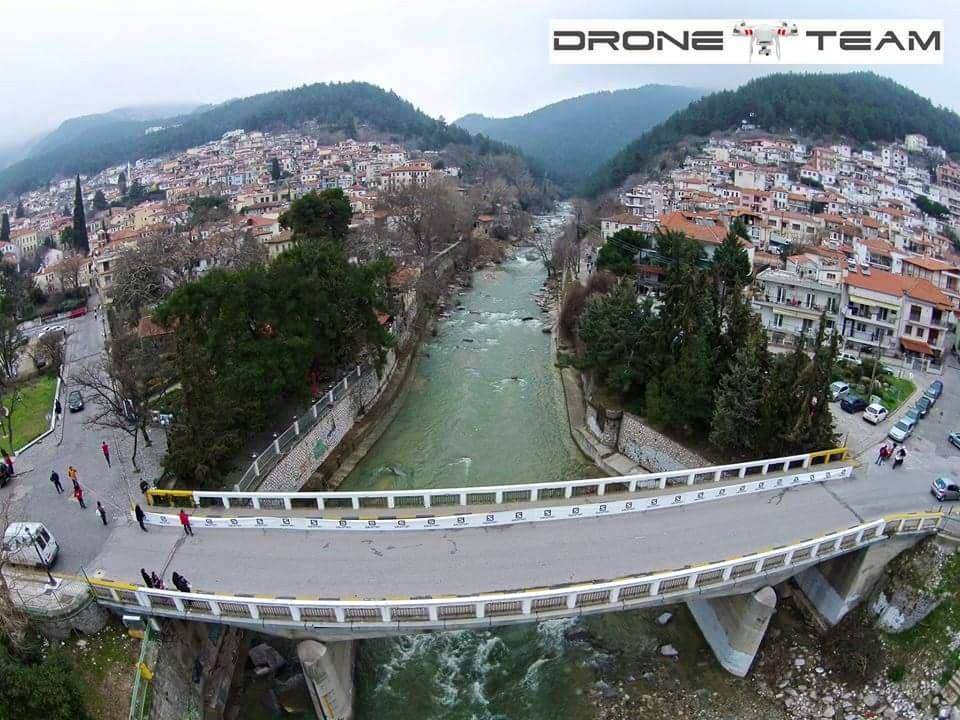
Kosynthos with its bridge from above (the creators of the photo are listed on it)
Links with interesting material about Xanthi and Thrace
Municipality of Xanthi
https://www.cityofxanthi.gr/
Xanthi – Municipality advertising spot
Old Town of Xanthi: An open-air museum
Old Town of Xanthi
Xanthi “City of Dreams” – Manos Hadjidakis – Residence
Xanthi’s bazaar – (360⁰ VR)
The Tobacco Warehouses area of Xanthi
The Byzantine castle of Xanthi
Greece – Xanthi – DJI Phantom 3 – Kosynthos River
Professional and Tourist Guide of Xanthi
https://odigosxanthis.gr/
About the Armenian community of Xanthi
https://armenika.gr/koinotita/127-koinotites/386-armenioi-tis-xanthis
Old blog Xanthi
https://oldxanthi.blogspot.com/
News site
Website about Thrace
www.thraki.com.gr
Website about the culture of Xanthi
https://cultureofxanthi.gr/
Website about entertainment
